2 Volumes
Rt. Angle by Years
The history of Philadelphia"s finest men's club.
Reminiscences, In Memoriam, The Right Angle Club,
Philadelphia doesn't toot its own horn very much. A central part of its charm is the wealth of anecdotes, and many charming characters, known only to insiders. You have to be a real Philadelphian to know very much of this lore.
Right Angle Club 2010
2010 is coming to a close, a lame-duck session is upon us, and probably after that will come two years of gridlock. But the Philadelphia Men's Club called the Right Angle, keeps right on talking about the current scene. A few of these current contents relate to speeches given elsewhere.

Dear Right Angle Members:
I write this letter with great pleasure to recap the events of 2010. First, it is absolutely necessary to recognize the exemplary efforts of the Officers and Board of the Right Angle Club. Throughout my career I gave those in a position of responsibility all the room they needed to accomplish their job. The officers and Directors who served with me rose to all occasions during the year. It was a distinct pleasure to serve with them and witness their thoughtful, studied approach.
 The team consisted of 1st Vice President John J. White, whose primary focus was membership. Despite an immediate drop of membership during the first days of our tenure, John's leadership allowed us to stabilize the membership base. We introduced Affiliate Memberships, a new membership category designed to attract younger members who can't attend a weekly lunch. We also set up a social event to encourage members to get their friends involved. The cocktail party was a good opportunity for prospective members to see what a fine group we are. That social was successful and will continue twice a year.
The team consisted of 1st Vice President John J. White, whose primary focus was membership. Despite an immediate drop of membership during the first days of our tenure, John's leadership allowed us to stabilize the membership base. We introduced Affiliate Memberships, a new membership category designed to attract younger members who can't attend a weekly lunch. We also set up a social event to encourage members to get their friends involved. The cocktail party was a good opportunity for prospective members to see what a fine group we are. That social was successful and will continue twice a year.

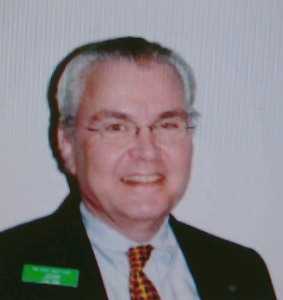 3rd Vice President John Fulton, had the daunting task of organizing speakers for our weekly Friday Luncheons. John, with all the aplomb characteristic of him, handled the matter. He produced speaker after speaker of great interest and continued this wonderful tradition. The following pages will highlight those fine speakers who presented their thoughts and experiences.
3rd Vice President John Fulton, had the daunting task of organizing speakers for our weekly Friday Luncheons. John, with all the aplomb characteristic of him, handled the matter. He produced speaker after speaker of great interest and continued this wonderful tradition. The following pages will highlight those fine speakers who presented their thoughts and experiences.
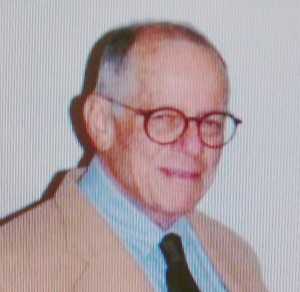 4th Vice President Mel Buckman presided over our weekly raffles with precise action. He handled the tickets and the final count out of prize money. Nerve racking to say the least but he handled this with a flair for presentation at all times.
4th Vice President Mel Buckman presided over our weekly raffles with precise action. He handled the tickets and the final count out of prize money. Nerve racking to say the least but he handled this with a flair for presentation at all times.
 Our Corresponding Secretary Jack Hinkle wrote the monthly newsletter with the wit of a multitude of witty people. He never missed a date and made each read full of chuckles. In addition, we always had the proper recognition plate to present to speakers and new members.
Our Corresponding Secretary Jack Hinkle wrote the monthly newsletter with the wit of a multitude of witty people. He never missed a date and made each read full of chuckles. In addition, we always had the proper recognition plate to present to speakers and new members.
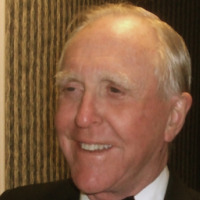 Recording Secretary David Richards took our Board meeting notes. He tracked literally thousands of words, and kept our records coherent and organized. Thank you David.
Recording Secretary David Richards took our Board meeting notes. He tracked literally thousands of words, and kept our records coherent and organized. Thank you David.
 Archivist David McCormack put away all our records for posterity. He also happily kept track of our stock of ties and other club offerings.
Archivist David McCormack put away all our records for posterity. He also happily kept track of our stock of ties and other club offerings.
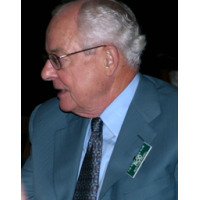 Treasurer Rod Rothermel continued to record our income and expenses with accuracy, producing reports each month. He also managed to pull the board meeting conversation back on track many times.
Treasurer Rod Rothermel continued to record our income and expenses with accuracy, producing reports each month. He also managed to pull the board meeting conversation back on track many times.
The Board consisted of members Peter Alois, Alan Lawley, Jeremy Leon and Dan Sossaman. These men all offered valuable insight to the many points of discussion during our meetings. The board collaborated on content for our web site which now contains the following information:
- General Information
- Club Meeting Dates
- Officers
- Directory
- History
- Past Presidents
- Administration & Procedures
- Constitution
- By Laws
- Procedures: Membership
- Procedures: Events
- Procedures: Speakers
- Procedures: Raffles
- Forms
- Membership Application
- Weekly Meeting Agenda
- Board of Control Agenda
- President's Dinner Format
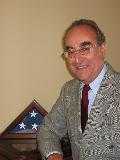
|
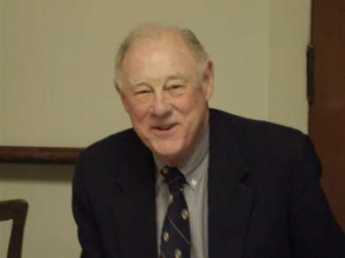
|

|
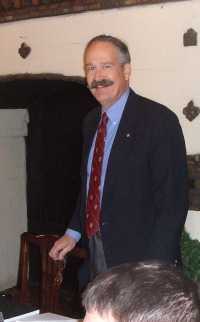
|
Soon to come will be a member picture sheet printable for carrying about. Of course, all of the above is printable, from the Membership Application to the full Directory. We will continue to tweak the process, improving its capacity and use.
All in all this was a very exciting year. Thank you for letting us serve the Right Angle Club.
Sincerely,
Joseph A, Martinez Jr.
Christmas Reflections
My father in law, a prominent obstetrician in Binghamton, New York, regularly took his family to New York City sometime between Thanksgiving and Christmas. The three-day junket was described as a visit to do Christmas shopping. Another relative made similar trips from home in Tyler, Texas. Several of my patients made such visits to Philadelphia from their homes in West Virginia, stopping by to make a medical visit to me during the same trip. From the seasonal crowds in Penn Station and in the shops on Chestnut Street, it was clear that an annual visit to the big city was a common custom in the upper crust of small to medium-sized cities, for whom the more expensive shops of the bigger city provided big-ticket items bought infrequently, and the distinctive luxuries which made them stand out from the socially less-enlightened back home.
These shopping visits were not confined to purchasing, although that was the main focus. It was a time to go to the theater, orchestra and opera, maybe an occasional ballet and art exhibit. The choice of a large city might be related to returning to the University, or another period of professional training for a drop-in visit because these associations made it possible to observe the latest trends and innovations, a useful issue in the smaller towns. The ladies could observe the trends in fashions, and everyone would have a chance to dress up in the better hotels and restaurants. This recirculation between the small towns and the big one at the hub unified the region, establishing hierarchy rather widely. And it hardened traditions in the big city, since islanders tend to return to the same hotel, restaurants and social gathering spots even more than the local residents do; there isn't time in a brief visit to shop for new venues, unless the trip itself reveals that times and places have somehow changed in an important way.
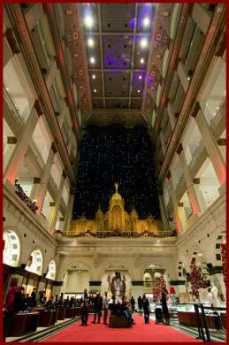 |
| Wannamakers Pipe Organ |
That's all changed, today. The pipe organ at Wannamakers, the cluster of department stores around Eighth and Market, the theater district, Caldwell's and Bailey Banks and Biddle upscale jewelers, the fancy women's clothing shops on Walnut and Chestnut Streets, and the bespoke men's tailor shops -- have disappeared in a slew of retail despond. The excited crowds of upscale shoppers have dwindled, at least in the center city shopping area. Students of sociology point to the decline of the department store as a central commotion in the center of this phenomenon, blaming that in turn on the spread of national brand names by television and more electronic forms of advertising. The department store did your comparison shopping for you, putting its brand name on the product and placing its reputation behind the choice. If Wannamaker could determine that a Japanese radio was of high quality, it became Wanamaker's radio. Today, Samsung and Sony do their own advertising, sell their products through outlets in the suburban malls. Philadelphia residents enjoy as much retail choice and pricing as ever, they just shop in the malls located along the Interstate circumferential highway, just outside what used to be the outermost suburbs. So the volume of retail shopping among Philadelphians probably hasn't changed a great deal; it has merely shifted to the malls where there is parking for your car to transport goods which the department stores used to deliver. It is the annual visits from the subordinate small cities at moderate distance that has disappeared. Small cities now have their own shopping malls, carrying national brand name merchandise. Losing this source of business, the associated entertainment industry has declined to a point below sustainability for most of them -- in the center city hub. Along with the disappearance of this regional recirculation, small cities have lost their sense of affiliation with a bigger one. The small-town professional class which was the biggest participant in this annual migration is professionally more isolated but so are their clients. The upper crust of the small town now must constrain its horizon to the smaller town professionals, with their lesser claim to distinction. For a while, the disparity can be overcome by specialization, but ultimately the distinction of the big-city specialist rests on assembling a richer experience from wider drawing power. In Medicine at least, the insistence of Medicare on paying the same fee for the same service lessens the economic incentive for self-repair of the system.
 |
| Wannamaker's Christmas Light Show |
Meanwhile, nature of Christmas itself is becoming standardized. Fewer people make their own Christmas presents, whether through knitting or baking. If the process of commercial gifts goes the full distance, eventually the joy of searching for exactly the right gift will seem more like paying your taxes. These things already cost too much, are worth too little, and neither the process of giving a gift nor the process of receiving a welcome gift will retain much joy. Or significance. What was until recently a Christian religious celebration has become diversified into a generic "Happy Holiday", presumably in order to avoid offense to other religious groups who themselves likely persist in their old traditions of ritual greeting. The assault on Christmas is however not primarily cultural, but commercial. The silent ostentation of elaborate outdoor lighting and the secular versions of Christmas carols endlessly replayed over loudspeakers in stores, probably have a more destructive effect on the community winter solstice ceremony than any competition for religious adherence.
The coming next step in the modification of the Christmas season is dimly visible in the assault of pocket telephones on the suburban shopping mall. After enjoying only a few years of victory over the center city department store, malls must now confront shoppers with portable telephones containing a camera and GPS geographical locator. Seeing something he likes, the shopper of the future can photograph its bar code in the shop display, and be immediately told of all the neighboring stores which sell the same product for a lower price. Electronics are thus about to turn Christmas shopping into an electronic auction, no doubt making it eventually easier to do the shopping from home.
What Christmastime means to me is a recollection of what it once was like at the nation's oldest hospital, and not so terribly long ago, at that. Before 1965, the Pennsylvania hospital had been staffed for centuries with unpaid student nurses, working under the direction of unpaid doctors in training, supervised by volunteer attending physicians. Of the five hundred beds, only forty were filled with paying patients and the rest were housed in long communal halls. On Christmas morning at 7 AM, the drowsy patients were astonished to be awakened by a procession of very pretty student nurses, led by Miss McClellan the grim-looking Directress of nursing, and followed by a handful of internet and residents, all singing Christmas carols and carrying lighted candles in the dark. Miss McClellan herself was never heard to utter a note, but the student nurses had been trained in four-part harmony, and the interne doctors were enthusiastic followers. The faces of the poor old indigents in the beds were filled with pure delight as we traipsed past, chanting of the travels of Orient kings, the pregnancy of virgins, and other miracles of the occasion.
First Amendment: Separation of Church and State
 Amendment 1 Congress shall make no law respecting an establishment of religion, or prohibiting the free exercise thereof; or abridging the freedom of speech, or of the press, or the right of the people peaceably to assemble and to petition the government for a redress of grievances. 
|
| The First Amendment |
Simplified histories of America often declare that other Western Hemisphere colonists mostly came to plunder and exploit; whereas English Protestant colonists came with families to settle, fleeing religious persecution. That's a considerable condensation of events covering three centuries, but it is true that before the Revolutionary War, eleven of the thirteen American colonies approximated the condition of having established religions. Massachusetts and Virginia, the earliest colonies, had by 1776 even reached the point of rebelliousness against their religious establishments. The three Quaker colonies (New Jersey, Pennsylvania, and Delaware) were late settlements, in existence less than a century before the Revolution, and still comfortable with the notion they were religious utopias. While differing in intensity all colonials respected the habits of thought and forms of speech, natural to utopians residing in a religious environment.
Once Martin Luther had let the Protestant genii out of its religious bottle, however, revisionist logic was pursued into its many corners. Ultimately, all Protestant questers found themselves confronting -- not religious dogmatism, but it's opposite -- the secularized eighteenth-century enlightenment. Comparatively few colonists were willing to acknowledge doubts openly about miracles and divinity. However, private doubts were sufficiently prevalent among colonial leaders to engender restlessness about the tyrannies and particularly the rigidities of the dominant religions. To this was added discomfort with self-serving political struggles observable among their preachers, and alarm about occasional wars and persecutions over arguably religious doctrines. Arriving quite late in this evolution of thought -- but not too late to experience a few bloody persecutions themselves -- the Quakers sought to purify their Utopia by eliminating preachers from their worship entirely. Thus, the most central and soon the most prosperous of the colonies made it respectable to criticize religious leaders in general for the many troubles it was believed they provoked.

|
| London Yearly Meeting |
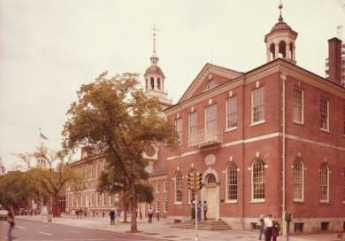
|
| Congress Hall |
In all wars, diplomatic arts and religious restraints get set aside as insufficient, if not altogether failures for an episode of utter barbarism. In the Revolution, some Quakers split from pacifism and became Free Quakers, many more drifted into Episcopalianism, never to return to pacifism. The Constitutional Convention of 1787 was eventually held in this persisting environment; the previous service in the War counted for something, and the great goal was to strengthen the central government -- for more effective regional defense. A great many leaders were Masons, holding that much can be accomplished by secular leadership, independent of religious reasonings. Neither Washington nor Madison revealed much of their religious positions, although Washington the church attender always declined communion; Franklin and probably Jefferson were at heart deists, believing that God might well exist, but had wound up the universe like a clock to let it run by itself. The New England Calvinist doctrines have since evolved as Unitarianism, which outsiders would say theologically is not greatly different from deism. Physically surrounding the Philadelphia convention was a predominantly Quaker attitude; entirely too often, preachers get you into trouble.
When the first Congress finally met under their new constitution, they immediately confronted over a hundred Constitutional amendments, mostly submitted from the frontier and fomented by Jefferson and Patrick Henry, demanding a bill of rights. The demand within these amendments was overwhelming that the newly-strengthened central government must not intrude into the rights of citizens. Recognizing the power of local community action, states rights must similarly be strengthened. Just where these rights came from was often couched in divine terms for lack of better proof that they were innate, or natural. From a modern perspective, these rights in fact often originated in what theologians call Enthusiasm; the belief that if enough people want something passionately enough, it must have a divine source. The newly minted politicians in the first Congress recognized something had to be done about this uproar. Congress formed a committee to consider matters and appointed as chairman -- James Madison. Obviously, the chief architect of the Constitution would not be thrilled to see his product twisted out of shape by a hundred amendments, but on the other hand, a man from Piedmont Virginia would be careful to placate the likes of Patrick Henry. The ultimate result was the Bill of Rights, and Madison packed considerably more than ten rights into the package, in order to preserve the cadence of the Ten Commandments. The First Amendment, for example, is really six rights, skillfully shaped together to sound more or less like one idea with illustrative examples. Overall freedom of thought comfortably might include freedom of speech (and the press), along with freedom of religion and assembly, and the right to petition for grievances. But what it actually says is that Congress shall not establish a national religion. Since eleven states really had approximated a single established religion, the clear intent was to prohibit a single national religion while tolerating unifications within the various states. Subsequent Supreme Courts have extended the Constitution to apply to the states as well, responding to a growing recognition that religious states had the potential to get so heated as to war with each other. No matter what their doctrines, it seemed wise to deprive organized religions of political power as a firm step toward giving the Constitution itself dominant power over the processes of political selection.
At first however it was pretty clear; one state's brand of religion was not to boss around the religion of another state. Eventually within one state, Virginia for example, the upstate Presbyterian ministers were not to push around the Episcopalian bishops of the Tidewater. Madison and Jefferson saw well enough where political uprisings tended to start in those days, in gathered church meetinghouses. In this way, an Amendment originally promoted to protect religions had evolved into a way to ease them out of political power. The idea of separation of church and state has grown increasingly stronger, to the point where most Americans would agree it defines a viable republic. No doubt, the spectacle of preachers exhorting the same nation in opposite directions during the Civil War, settled what was left of the argument.
For Quakers, the most wrenching, disheartening revelation came when they were themselves in unchallenged local control during the French and Indian War. The purest of motives and the most earnest desire to do the right thing provided no guidance for those in charge of the government when the French and Indians were scalping western settlers and burning their cabins. Yes, the Scotch-Irish settlers of the frontier had unwisely sold liquor and gunpowder to the Indians, and yes, the Quakers of the Eastern part of the state had sought to buffer their own safety from frontier violence by selling more westerly land to combative Celtic immigrant tribes. A similar strategy had worked well enough with the earlier German settlers, but reproachful history was not likely to pacify frontier Scots in the midst of a massacre. The Quaker government was expected to do what all governments are expected to do, protect their people right or wrong. To trace the social contract back to William Penn's friend John Locke was too bland for a religion which prided itself on plain speech. Non-violent pacifism just could not be reconciled with the duties of a government to protect its citizens. The even more comfortably remote Quakers of the London Yearly Meeting then indulged themselves in the luxury of consistent logic; a letter was dispatched to the bewildered Quaker Colonials. They must withdraw from participation in a government which levied war taxes. And they obeyed.
Although the frontier Scots were surely relieved to have non-Quakers assume control of their military duty, the western part of the state has still neither forgotten nor forgiven. In their eyes, Quakers were not fit to be in charge of anything. Quaker wealth, sophistication and education were irrelevant; only Presbyterians are fit to rule. A strong inclination toward pre-destination lurks in that idea. Once more, the attractiveness of clear separation of church and state is reinforced.
The French and Indian War in fact had turned out fairly well; most of its victories were located on the European side of the Ocean, anyway. But twenty years later the Revolutionary War turned into a reassertion of the British conquest of all of North America, not merely the part to the west of the Appalachian mountains. To Americans, this came in the form of a demand for taxes to help pay off the costs of a war which greatly benefitted them. The Quaker colonies did not fully sympathize with rebellion, but they had once given up control of a territory larger than England rather than pay war taxes, so they were resistant to both sides in the dispute. Many prosperous and educated Quakers solved their dilemma by fleeing to Canada, but the ardent Quaker proposal for dealing with a coercive British government was not at all impractical. John Dickinson, in particular, argued that since the British motives were economic, success was most likely to come from economic counter-pressure, adroitly leveraged by three thousand miles of intervening ocean. That was shrewd and potentially effective. But the Scots-Presbyterian position was simpler and more direct. If you want us to fight your war, you are going to have to fight to win. The Virginia Cavaliers were probably more likely to win a conventional war if put in charge, but the blunt and almost savage frontiersmen were ideally suited for what has come to be called guerrilla warfare. Washington was a leader, French money was welcome and Ben Franklin was a diplomat, but the clarion call to this particular battle was the voice of Patrick Henry. All in all, the issue of established religion was far more complicated than merely the affirmation of a right to free exercise of religious belief. What united all the colonies was a recognition that, using the church, an arm of the government was just as likely to cause trouble as conducting the state as an instrument of church interests. Eventually, considering how religious America was at the time, there was remarkably little resistance to the firm separation of Church and State in its Constitution.
Puritan Boston & Quaker Philadelphia
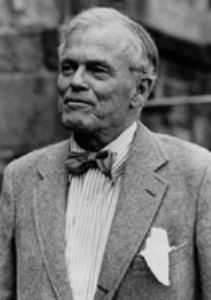
|
| Professor Digby Baltzell |
Digby Baltzell had something of the defiant rebel in him. He surely didn't imagine his employer, the University of Pennsylvania, was pleased to have him a document that Harvard is a better college than Penn. Nor were fellow members of the Philadelphia Club pleased to confront scholarship that his city's gentry was too devoted to money-making to accept the ardors of public leadership. Nor would his relatives in the Society of Friends enjoy accusations their religion impaired the pursuit of excellence in all fields of the city's endeavor. Later articles will here take up some unfair assaults, and defend Quaker simplicity and Peace Testimony. Some blame must, of course, be shared, some mitigating circumstances acknowledged. And let it be said in Baltzell's support that it truly is remarkable how many cultural features do get passed down for ten or more generations. Or even longer; look at the persistence of ancient Chinese, Indian, Esquimo, Viking, Roman, Christian and other cultural heritage. The Quakers got to Pennsylvania early, they are now vastly outnumbered. Many Quaker ideas continue to influence present inhabitants, some ideas probably hold us back. Substitute "Puritans of Boston" for "Quakers" in the foregoing sentence, and conclude by saying "some of those ideas probably give Bostonians an edge". Those two rather unexceptional declarations summarize a controversial book, although they do not completely capture its overall censorious flavoring.
To a certain extent, Digby is his own worst enemy. While alive, he was one of the world's most charming raconteurs, a walking encyclopedia of local lore. Like a good docent in a museum, he could walk into a room hung with portraits, and charm any audience for an hour; presumably, his sociology lectures at Penn held the same magnetism for his classes. In a book for popular readers, however, it is overdone to go on about the same point for six hundred pages. He needed a better editor, or perhaps he needed to permit a better editor to make him restrain his tendency to multiply illustrations beyond the point where the reader loses the thread of the argument. Not all readers will agree with his argument; they can only be legitimately defeated by focused argument. That's perhaps unrequired of college professors holding the power of grade-point averages over nineteen-year-olds, but it is expected of conversation with other adults. If an editor wants to sell books to a general bookstore audience, he should induce authors to overcome the take-it-or-leave-it habit.
As a general reaction to this book, Baltzell seems to think Quakers do not want to be rich and that consequently, latecomers into the region tend to share this feeling. My own view is that Quakers see they can have almost all of the value of being moderately rich -- by disdaining the trivial luxuries of the middle classes. They do not exactly renounce fame and power but are unwilling to gamble much or sacrifice much, in order to enjoy the comparatively small exhilaration of being very rich. They are now no longer surrounded by junior versions of themselves, but by bank-robbing Willie Suttons who readily attack Quakers for being where the money is, and appear to be pushovers at that. When Quakers then promptly demonstrate they are not pushovers at all, they are treated like outsiders in their own town. In many ways and at most times, the populist crowd gives up trying to understand Quakers and decides they must somehow always behave in ways that others would not. It's hard to achieve much deference in such an environment.
Many of Baltzell's important insights grew out of his position as a Philadelphia and academic insider; he personally knew many of the people he described. However, such an infiltrator runs the constant risk of being viewed as a tattle-tale, so a cover is required. Batzell's technique involved frequent use of quotations from others, not so much to prove a point as to rephrase it. This is another feature of the book which might have benefited from a hard-nosed editor. However this is how he wanted it, and in a post-publication revision, here is a condensation of how he summarizes his argument:
When studied with any degree of thoroughness, the economic problem will be found to run into the political problem, the political problem, in turn, run into the philosophical problem, and the philosophical problem itself to be almost indissolubly bound up at last with the religious problem.
--Irving Babbitt
In the South, ....left-wing Quakers came to the fore in the pine barrens of North Carolina-- to this day, North Carolinians speak of their state as "a valley of humilities between two mountains of conceit."
--E. Digby Baltzell
The world is only beginning to see that the wealth of a nation consists more than anything else in the number of superior men it harbors.
-- William James
I believe that ambitious men in democracies are less engrossed than any other with the interests and judgments of posterity; the present moment alone engages and absorbs them...and they are much more for success than for fame. What appears to me most to be dreaded, that in the midst of the small, incessant demands of private life, ambition should lose its vigor and its greatness.
-- Alexis de Tocqueville
Our rulers today consist of a random collection of successful men and their wives. ....They have been educated to achieve success, but few of them have been educated to exercise power. Nor do they count with any confidence upon retaining their power, nor of handing it on to their sons. They live therefore from day to day, they govern by ear. Their impromptu statements of policy may be obeyed, but nobody seriously regards them as having authority.
--Walter Lippmann
Equalitarians holding...extreme views have tended to believe that men of great leadership capacities, great energies or greatly superior aptitudes are more trouble than they are worth.
--John W. Gardiner
In the Jacksonian era in this country, equalitarianism reached such heights that trained personnel in the public service were considered unnecessary...Thus, in the West, even licensing of physicians was lax, because not to be lax was apt to be thought undemocratic.
--Merle Curti
In the late eighteenth century we produced out of a small population a truly extraordinary group of leaders-- Washington, Adams, Jefferson, Franklin, Madison, Monroe, and others. Why is it so difficult today, out of a vastly greater population, to produce men of that character?
--John W. Gardiner
It is nevertheless certain that the high quality of Virginia's political leadership in the years when the United States was being established was due in large measure to those very things which are now detested. Washington and Jefferson, Madison and Monroe, Mason, Marshall, and Peyton Randolph, were products of the system which sought out and raised to high office men of superior family and social status, of good education, or personal force, of experience in management: they were placed in power by a semi-aristocratic political system.
--Charles S. Syndor
Another clue to the relationship between hierarchy and leadership is suggested by Gardner's list of the Founding Fathers. All of these men were reared in Massachusetts or Virginia; none was reared in the colony of Pennsylvania, though Philadelphia was the largest city in the new nation and contained perhaps the wealthiest, most successful, gayest, and most brilliant elite in the land. Not only had Pennsylvanians little to do with taking the lead in our nation's founding, but the state has produced very few distinguished Americans throughout our history...I shall concentrate here on the commercial cities of Boston and Philadelphia, whose great differences in leadership and authority were far more likely to reflect differences in ideas and values.
--E. Digby Baltzell
Whatever else ...America came to be, it was also an experiment in constructive Protestantism.
--H. Richard Niehbur
All this is only to say that man is a product of his history, where nothing is entirely lost and little is entirely new.
--E. Digby Baltzell
For the wine of New England is ...more like the mother-wine in those great casks of port and sherry that one sees in the bodegas of Portugal and Spain, from which a certain amount is drawn off each year, and replaced by an equal volume of the new. Thus the change is gradual, and the mother wine of 1656 still gives bouquet and flavor to what is drawn in 1956.
--S.E. Morison
New Englanders, ambitious beyond reason to excell.
--Henry Adams
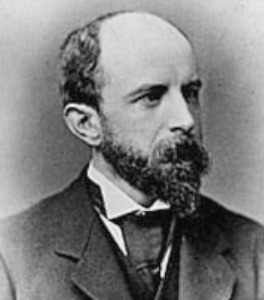
Henry Adams Pennsylvania became the ideal state, easy, tolerant and contented. If its soil bred little genius, it bred less treason. ... To politics, the Pennsylvanians did not take kindly. Perhaps their democracy was so deep an instinct that they knew not what do to with political power when they gained it; as though political power was aristocratic in its nature, and democratic power a contradiction in terms.
--Henry Adams
The reproach I address to the principles of equality is that it leads men to a kind of virtuous materialism, which would not corrupt, but would enervate the soul, and noiselessly unbend its springs of action.
--Alexis de Tocqueville
In our egalitarian age of mistrust, trustworthy men of great ability are increasingly refusing to run for public office or to serve in positions of authority and leadership in our society...In the rest of this book, I shall try to show how and why the Quaker city of Philadelphia, in contrast to Puritan Boston, has suffered from that virus of virtuous materialism for almost three centuries and how its best men, on the whole, have seldom sought public office or positions of societal authority and leadership outside business.
--E. Digby Baltzell
REFERENCES
| Puritan Boston and Quaker Philadelphia: E. Digby Baltzell. ISBN-13: 978-1560008309 | Amazon |
William Penn, Excellent Lawyer, Terrible Businessman
Richard Dunn, who with his wife Mary Maples Dunn stand as the two core authorities on the life of William Penn, merely smiles when asked to describe what Penn was really all about. "What we need is to have one good biography emerge," said he, "but it isn't easy to guess what it will say". For the present, let's just sketch a few paradoxes which somehow need threading together.
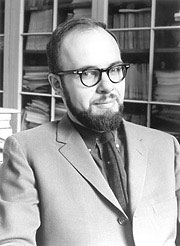
|
| Richard Dunn |
In the first place, the wealth of William Penn can only be described as prodigious. His father had played a central role in restoring the Stuart monarchs, and in the course of it had conquered for the Crown the enormously valuable property of the Island of Jamaica. For these efforts, the father had been rewarded with extensive properties in Ireland and a highly influential position at Court. To all of this was overgenerously added as debt repayment, the American territories which have now become the states of Delaware, New Jersey, and Pennsylvania. Actual ownership of some of this was shared with others, but all of it was quite effectively controlled by young William. No one else stands even close as the largest private landholder in American history. But to appreciate the immensity of his wealth, it should be understood that he treated this property as a sort of hobby. Over the course of his lifetime, the colonies lost money, and Penn subsidized them rather seriously from his other assets.
At the same time, Penn lived vastly beyond his income in ordinary ways, becoming heavily indebted, eventually going to debtor's prison. It probably was not necessary; his sons renounced Quakerism and made a profit on the colonies after they inherited them. Although he could display remarkable organizational talent, particularly in the organization of New Jersey, his management was mostly slack, his judgment of agents often proved too trusting, and he permitted himself to be exploited by poorly-designed contracts to his eventual financial ruin. Even that might not have been serious; he displayed a towering legal mind in the devising of the doctrine of jury nullification and was the winner in a great many lawsuits. He even demonstrated he was capable of winning dubious lawsuits, soundly defeating Lord Baltimore in a border dispute over Maryland which others have said showed Baltimore had the stronger case. We know he had influence at Court, and such legal victories suggest he might on occasion have taken full advantage of it.

|
| Gulielma Maria Springett Penn |
From the sound of things, some have concluded Penn was so rich and powerful he grew careless about his own best interests, which essentially needed very little defense. In particular, he gave this impression to his fellow Quakers, who concluded he did not need nor likely would stoop to collecting what he was owed in taxes and property sales. This cavalier attitude encouraged the early Quaker merchants to follow their own advantage without shame, and as it happened with great vigor. The Constitutions he devised for the colonies are frequently cited as the brilliant cornerstones of fairness and stability, ultimately the models for much of our present Constitution. Penn really was sincere in wanting to provide a better life for the working people than they could have at home in England. But in the Seventeenth Century, the modest role he devised for the Proprietor commanded little respect and was not one his aggressive clients would have chosen for themselves in his position. Perhaps the most generous description of their passive aggression would be that he taught power and governance to be the collective possession of the whole Quaker meeting, so the leaders of the meeting simply took him at his word. For their part, there can be little doubt of their commercial talents; trade and industry immediately thrived in the colony. However, sharp, aggressive trade and commerce were not things a gentleman would himself want to associate with.
Unfortunately, the historical records of the early colonies are not good; for the most part, we have to surmise the struggles and frictions between a rich, financially careless, and sincerely earnest theologian in his contention with a group of poorly educated strivers who had been told he regarded each of them to be his equal. As the saying goes, he was rich beyond denying. And therefore, he was probably arrogant beyond his own ability to see it as a flaw.
Equal before the law, perhaps, and equal in the prayers of First-day Meeting. But everything about his upbringing, his social circle in London, and his staggering wealth suggested that even a saint would have trouble believing, deep in his heart, that these were truly his equals. And even if perchance he did believe it, they would not have believed it for a moment, had their positions been reversed. Penn certainly acted as though he believed in religious freedom, serene in the idea that if every person earnestly thought hard about ethical issues, everyone would eventually reach about the same conclusion. The elders of the meeting, however, behaved in ways which suggested they would personally prefer non-Quakers to settle somewhere else, and given half a chance would create Quakerism as an established church. There seemed to be those who felt that Friend William was perhaps a little too trusting. And anyway there were some obvious paradoxes. William Penn kept personal slaves.

|
| Hannah Callowhill Penn |
With two wives, William Penn had thirteen children. Among them was considerable diversity of opinion, along with the same tendency to rebellion found in any two generations. Early illnesses and chance led to the emergence of those children who renounced Quakerism and showed no shame at all about wanting to have money in order to spend it recklessly. One would have supposed that a man of Penn's intellectual stature would have been able to control his family better, but his own reckless youth had been so extreme that he had few arguments available when, as seems virtually certain, rebellious children defended themselves by reminding him of his own indiscretions. William Penn displayed absolutely no sense of humor; a touch of it would have been useful in mastering a family and friends who were undoubtedly having a little trouble knowing what to make of this apparition in their midst. Some equally pompous Pennsylvania merchants might have had difficulty denying that in their passive aggression, they occasionally resembled the spoiled brats with whom he found he had ample family association.
REFERENCES
| Remember William Penn, 1644-1944: A Tercentenary Memorial : Edward Martin: ISBN-13: 978-1258369934 | Amazon |
The Republican Court
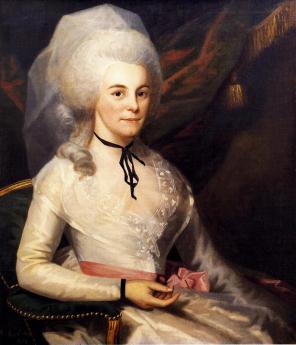
|
| Elizabeth Schuyler Hamilton |
A popular legend of our founding fathers depicts a sudden 18th Century flowering of talent, even genius, establishing a new nation. More recently, historians have searched for personal material about the individual founders, humanizing them with warts, so to speak. A question nevertheless arises how a nation with the present population of Detroit could produce such outstanding leadership in what was then a scattered colonial frontier region. Men, that is. In our legends, the founders were all men.
Long before the feminist movement gathered momentum, historians like Rufus Wilmot Griswold and Abigail Adams Smith had chronicled the impact of the high society of George Washington's term of office as president, which was in part a conscious effort by Washington to show the new republic to the world, cutting just as fine a figure as the nations of old Europe. Martha Washington, soon called Lady Washington, was an uncomfortable central figure in the new social scene, and her dismay at being the President's wife, her anxiousness to retire from prominence as soon as his term was over, suggest the idea for a Republican Court probably did not start with her. Elizabeth Schuyler Hamilton, Alexander Hamilton's wife, might seem more likely but the real originator is not known. For present purposes, a plausible theory is that soldier George Washington and bachelor James Madison had the concept but couldn't pull it off; and then some determined ladies of the court soon showed them all, what was what.
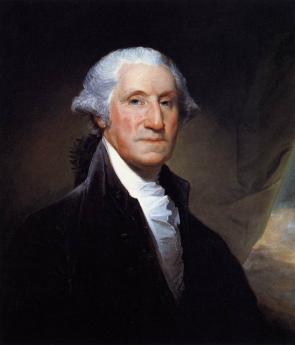
|
| George Washington |
George Washington began the process by instituting formal receptions for visiting males and Martha cooperated by holding Friday evening receptions, at which she was introduced to the wives of important political figures. The regular weekly events of the Presidency soon consisted of a reception by George Washington for new foreign ambassadors and other important foreign visitors, with a formal state dinner with a politically balanced invitation list on Thursday evening, and Lady Washington's reception on Friday with primarily a social purpose, leaning somewhat in the direction of letting the wives of important politicians shine in the social limelight. While the receptions were usually conducted with scripted formality, some notable exceptions were thought worthy of comment. Over twenty years earlier, Washington at Valley Forge had danced for three hours with Cathy Greene, the wife of Nathaniel Greene. When the widow Greene passed through one of the much later presidential levees, Washington suddenly bent over and kissed her, as "an impromptu act of spontaneity." The effect of the levees was to unite the elites of wealth and power, coming to Philadelphia from all thirteen colonies, now risen to statehood. Plantation owners from the South, ship owners, and merchants from the North met the daughters of socially prominent families and quite frequently married them. A courteous and civilized environment unified the new nation at its pinnacle by having local leaders mixing with other local leaders, becoming national leaders in the process. A politician in this new nation could rise to being someone of consequence socially. To be skillful in the social graces, particularly if there was wealth associated, was to advance in politics; to be boorish or loutish was to drop down somewhat in the scale of political influence, slowly but surely losing power to those who did have such graces. Put a backwoods politician into new formal clothes, force him to behave in an unaccustomed way in the midst of those more skillful at it, enlist the fearsome pressure of his ambitious wife to shine in the spotlight; and the fear of looking foolish soon enough pushes him toward conformity.

|
| Anne Willing Bingham |
After the first year, then the developing Republican Court. Martha Washington, of course, had her own mansion at Mount Vernon, but Anne Bingham had one within easy walking distance of Independence Hall. The Wife of the richest man in America, Anne Willing Bingham was the daughter of Thomas Willing the head of the most prominent merchant family in Philadelphia. Anne's husband William Bingham had achieved richest-man status at the age of 28 (by running a large privateer fleet in the Caribbean)and was not only able to build a splendid mansion patterned after that of a London aristocrat at 3rd an Spruce Streets,but had taken his young and beautiful wife on an extensive tour of the royal courts of Europe which lasted several years. It is said that Robert Morris later contributed to his own bankruptcy by attempting to match the Bingham mansion with a Morris mansion at 7th and Market, which had to be torn down for lack of money before it was completed. Since most of the wealthy hostesses attempting to achieve prominence in the newly forming Court had never been to Europe, there was no choice but to accept the judgment of Mrs. Bingham in such matters, especially since she had the biggest showplace in town. While the truth of a story about her is uncertain, it accurately illustrates the flavor of the social atmosphere that it could be said that the Dauphin, heir to the throne of France, once went to her father to request her sister's hand in marriage. The young prince was then living in exile at 4th and Locust, in temporarily impoverished circumstances. Old Tom Willing, as the story goes, said No. "If you do not become the King of France, you will be no match for her. And if you do become the King, she will be no match for you."
It does seem to be true almost every prominent lady in the Republican Court was described by contemporaries as astonishingly beautiful, but at least in the case of Anne Willing Bingham, her surviving portraits support this description. John Adams, who had his brilliant wife Abigail for comparison, was overwhelmed by Mrs. Bingham's ability to hold her own on political subjects at the dinner table. And George Washington, who loved to dance with the prettiest lady available, greatly favored Anne as a partner. In time, she asserted herself to the extent of pestering Washington into having his portrait painted by Gilbert Stuart when the painter was in town. Washington ordinarily disliked having his pictures painted, avoiding it when he could. There are nevertheless a great many pictures of Washington on display, crossing the Delaware and whatnot, all showing the same grim face. After his death, it became necessary for most of the many new pictures of him to attach the same Gilbert Stuart head to a variety of imaginary depictions. Benjamin Franklin, by contrast, seemed to enjoy the experience of being a sitter so there are many more portraits of him actually drawn fro life. Add Washington's social sponsorship an almost unlimited personal budget for parties, and Anne Bingham quickly established herself as the reigning queen of the court without even provoking Martha Washington's hostility. This was a busy ladies' world; one new arrival in Philadelphia described herself as exhausted by having to return the courtesy visits of ninety different ladies during her early weeks in town. The expense of such competition emerges from brief reflection on the variety of clothes needed to keep up with changing styles, and the elegance of carriages, footmen, etc.
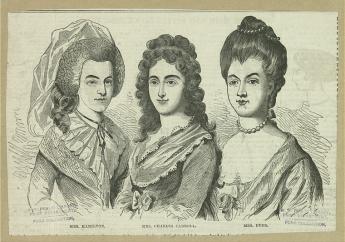
|
| The Chew Sisters |
Anne Willing Bingham was soon joined at the center of things by two Chew sisters, naturally referred to as astonishingly beautiful, who not only had their own mansions, but also Cliveden the summer place in Germantown as available venues for parties. It was commonly stated to be "social suicide, not to be home when the Chew sisters came to call." Delicious gossip was, of course, a strong undercurrent in such a social whirl, and Harriet Chew Carroll made a significant contribution. This daughter of Benjamin Chew the former Chief Justice (and Son of William Penn's personal lawyer)had married the son of very rich Charles Carroll of Carrollton, Maryland, but had to drop out of society because of notoriety associated with her abusively alcoholic husband. Similarly, Catherine Alexander Duer, who had married the son of the New Jersey patriot Lord Stirling, lost her social standing when her husband got deeply into debt in ventures with Robert Morris to the tune of today's equivalent of $40 million. As a Treasury official, there was a question of Duer's using public money to speculate privately, although he died in debtors prison before matters were completely clarified. His wife, who was known for having fifteen different wines on the dinner table, ended up her days running a boarding home to support herself. No doubt other transgressions were suppressed or covered up, while the political process was sufficiently advanced even in the early days of the Republic, to introduce some deliberate falsehood into the gossip mill. No doubt, one of the strongest drinks at the receptions was the bubbly wine of knowing all the inside scoop. And meanwhile, the potential disgrace of falling from favor was immensely powerful in enforcing conformity among those who might otherwise think themselves immune to it.
Some People were left out for various reasons, even if they could keep up financially or politically. It's always a little hard to identify why some people are social duds. Abigail Adams Smith seems to have been one of these, a constant source of adverse commentary about the extravagance, hypocrisy, etc., etc. English literature at this time has Jane Austen and William Makepeace Thackery, Pope Swift, and Dr. Johnson to satirize and constrain the social whirl, but American seems to have produced little more than correspondence and hushed remarks. The feeling of resentment was constantly growing in Republican circles, however, feeding a growing undercurrent of hostility undermining something so elitist and therefore somehow UnAmerican. After ten years in Philadelphia elegance, the District of Columbia was discovered to be scarcely more than a dismal swamp when the capital moved there, a place quite unsuited to high society. Dolley Madison revived things somewhat while acting as hostess for the widower Thomas Jefferson, and when her husband became the next President, opened her receptions to the general public. One can easily imagine the intense hostility of Andrew Jackson to any of this, however. Washington DC has since evolved a pallid political social whirl because America still has politically ambitious rich folks and plenty of money for indirect lobbying. But it hasn't ever been the same as the glory days in Philadelphia, and probably never will be. Present members of the financial/political elite who now work in Washington are in a great hurry to leave town every weekend, abandoning its empty office building to the tourists and civil servants.
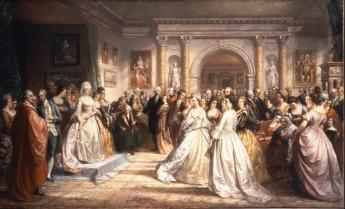
|
| The Republican Court |
The Republican Court served an important role in helping America unify thirteen colonies into a single nation. Because Philadelphia was for a time the center of the country, economically, socially and politically, all people of prominence in here, wanted to know each other. Variations of wealth and breeding stratified the women somewhat differently from the Variations of wealth and power of their husbands, ad constant mixing of the two strata unified the leadership of the new nation in ways that would have developed more slowly without it. The forced conversations of the receptions stratified independently but helped all the newcomers to the scene to adapt to the realities more comfortably. Each group, private and public watched a constant parade of aggressive climbers sort themselves out and searched for how they had made out; wealth got you to the top in one group, private and public, watched a constant parade of aggressive climbers sort themselves out and searched for how they had made out; wealth got you to the top in one group, power got you there in the other. But in both groups, the cruelties of social striving made the iron rule clear that such things as wit, gracefulness, physical attractiveness, education and breeding were qualities that floated you to the top of the soup of any flavor. When you are forming a new nation, perceptions of that sort are important to acknowledge. The American aristocracy could be circumvented among the many ways to the top, could be sneered at by those who lacked its unattainable features, and could be sniggered at by real aristocrats of real aristocracies in Old Europe. But it served well enough as a role model for a constant stream of new immigrants, and set a pattern for new communities of the interior, also seeking a sense of cultural direction. Like the breeding of horses and dogs that is such a constant upper-class avocation, there is a genetic message, too. Rich men marry beautiful women, so their children or grandchildren tend to be handsome. Handsome or not, gracefulness in social circles is learned at home. Darwin teaches you one thing, Adam Smith's hidden hand teaches another; both are worth attending to. Given eight or ten generations, this sort of evolutionary pressure forms a community, then a nation. It has certainly left major imprint on Philadelphia.

|
| Abigail Adams Smith |
On the rest of the nation as well, but in different ways. Along the East Coast, first families tend to persist and went to school so to speak in Philadelphia during Washington's presidency. Mary Ann Goodrich was a witty and Wealthy wife of a Connecticut political leader. Elizabeth Schuyler Hamilton was the famously vivacious wife of Alexander Hamilton of New York. Alice De Lancey Izard was the toast of Charleston, South Carolina. Patsy Jefferson Married Thomas Randolph of Virginia. Mary White Morris of Philadelphia had a bumpy trip as the wife of Robert Morris. In East Coast high society, the ladies usually have middle names.
Over three centuries, three main streams of immigrants plodded their way across the continent to the West and then merged. There were westward pioneers from north of Philadelphia with a certain kind of accent, from South of Philadelphia with another, and from Philadelphia with the normal way of talking. Each of them was following role models within its own cultural pattern, but the significance of middle names is now only a tip-off to insiders. There are patches of country, like Appalachia we are Texas, which brush off any allegiance to distant origins. But to the degree we are unified, the Philadelphia mixing bowl of the Social Scene during George Washington's presidency is a big part of how we got that way.
SEPTA's Long Term Planning
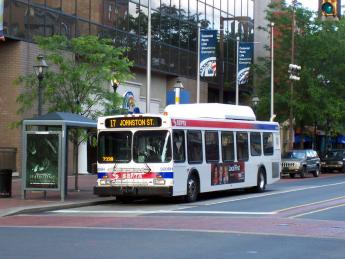
|
| Septa |
Byron S. Comati, the Director of Strategic Planning and Analysis for SEPTA (Southeastern Pennsylvania Transportation Authority), kindly gave the Right Angle Club an inside look at the hopes and plans of SEPTA for the near (five-year) future. Students of large organizations favor a five or six-year planning cycle as both short enough to be realistic, and long enough to expect to see tangible response. If plans continuously readjust to fit the five-year horizon, the concept is that the organization will move forward on these stepping stones, even accounting for setbacks, disappointments, and surprises. Furthermore, a serious level of continuous planning puts an organization in a position to react when funding opportunities arise, such as the sudden demand of the Obama Administration that economic stimulus proposals be "shovel ready."

|
| The Silverline V |
So, SEPTA is currently promoting five major expansions, based on the emerging success of an earlier plan, the Silverliner V. Silverline is a set of 120 shiny new cars, built in Korea on the model of electrical multiple units, which are expected in Spring 2011 to replace 73 cars or units which were built in 1963. Obviously, 120 are more expensive than 73, but they are more flexible as well. And less wasteful; most commuters are familiar with the model of three seats abreast which unfortunately conflict with the social preferences of the public, tending to make the car seem crowded even though it is a third empty. When a misjudgment like this is made, it takes fifty years to replace it with something better. For example, there's currently a movement toward "Green construction", which is acknowledged to be "a little bit more expensive". The actual costs and savings of green construction have yet to become firmly agreed on, so there's an advantage to being conservative about what's new and trendy in things that take fifty years to wear out.

|
| Septa Regional Map |
Four of SEPTA's five major proposed projects are in the Pennsylvania suburbs. New Jersey has its own transportation authority, and Philadelphia is thus left to struggle with the much higher costs of urban reconstruction assigned to its declining industrial population. And left unmentioned is the six hundred pound gorilla of the transportation costs of new casinos. A great many people are violently opposed to legalized gambling, and even more upset by the idea of crime emerging in the neighborhoods of gambling enterprises. Even the politicians who enacted this legislation are uncomfortable to see the rather large expenditures which will eat into the net revenue from this development. Nevertheless, if you are running a transportation system, you have an obligation to plan for every large shift in transportation patterns, no matter what you might think of the wisdom of the venture. The alternative is to face an inevitable storm of criticism if casinos come about, but without any preparation having been made for the transportation consequences. At present, the public transportation plan for the casinos is to organize a light rail line along the Delaware waterfront, connecting to the rest of the city through a spur line west up Market Street; it may go to 30th Street Station, or it may stop at City Hall. That sounds a lot like the present Market-Frankford line, so expect some resistance when the cost estimates are revealed. Because all merchants want to have the station stops near them, and almost no residents want a lot of casino foot-traffic near their homes and schools, expect an outcry from those directions, as well. It would be nice to integrate this activity with something which would revive the river wards, but it seems a long stretch to connect with Wilmington on the south, or Trenton on the north.
The planned expansions in the suburban Pennsylvania counties will probably encounter less controversy, although it is the sorry fate of all transportation officials to endure some hostility and criticism for any changes whatever. Generally speaking, the four extensions follow a similar pattern of building along old or abandoned rail lines, following rather than leading the population migrations of the past. When you are organizing mass transit, there is a need to foresee with some certainty that there will be a net increase in commuters in the region under consideration. The one and two passenger automobile is a much more flexible instrument for adjusting to the growth of new development, schools, retail, and industry. Once the region has become established, there is room for an argument that transportation in larger bulk is cheaper, cleaner or whatever.
The Norristown extension follows the existing but underused rail connections to Reading. Route US 422 opened up the region formerly serving the anthracite industry, but now the clamor is rising that US 422 is impossibly crowded and needs to be supplemented with mass transit.
The Quakertown extension follows the rail route abandoned in 1980 to Bethlehem and Allentown, although the extension is only planned as far as Shelly, PA.
The Norristown high-speed extension responds to the almost total lack of public transportation to the King of Prussia shopping center, and will possibly replace the light rail connection to downtown Philadelphia.
And the Paoli extension follows the mainline Amtrak rails as far as Coatesville.
All of these expansions can expect to be greeted with huzzahs by developers, land speculators, and newsmedia, but resistance will inevitably be as fierce as it always is. Local business always fears an expansion of its competitors; the feeling is stronger in the suburbs than the city, but local business always resists and local politicians always follow their lead. To some extent, the suburbs have a point, since radial extensions are usually much cheaper to build than lateral or circumferential transportation media; bus routes are the favored pioneers in connecting one suburb with another. Therefore, the tendency in these present plans remains typical by threatening the suburbs with a need to travel toward the center hub, then take a reverse branch back in the general direction of where they started, in order to go a short distance to a shopping center or school system. The two main river systems around Philadelphia interfere with the construction of big "X" routes from the far distance in one direction to the far distance in the opposite direction. Euclidian geometry makes the circumferential route elongate as the square of the radius. And jealousies between the politicians in three states create rally foci for the special local interests which feel injured. Since it seems to be an established fact that the proportional contribution to mass transportation by the surrounding suburbs of Philadelphia is traditionally (and considerably) lower than the national average, a political reconciliation might do more for the finances of SEPTA than any federal stimulus package could do. For such reconciliation, a few lateral connections in the net might pacify the suburbs enough to justify the extra cost. Unfortunately, the main source of unjustified cost in regional mass transit is the high wage and benefit levels of the employees, a situation inherited from the old days when commuter rail was part of the stockholder-owned regional railroads. Just as featherbedding was the main cause of the destruction of the mainline railroads, health and pension benefits threaten the life of mass transit. In the old days, local governments acted as a megaphone for union demands. So the railroads just gave the commuter system to the local governments, and let them wrestle with the unions themselves. Since the survival of the urban region depends on conquering this financial drain, the problem must be gradually worn down. But it has been remarkable how long the region has been willing to flirt with bankruptcy rather than bite this bullet.
If anything, this friction threatens to get worse. In 2009, for the first time, a majority of union members in America -- work for the government, the one industry which thinks it cannot be destroyed by losing money. True, SEPTA is not exactly a government function, but it has enough in common with a government department to arouse suburban voters, who regularly refer to it as an arm of the urban political machine. SEPTA isn't too big to fail, but there exists little doubt that government at some level would probably try to bail it out if it did.
Forming the State of Delaware
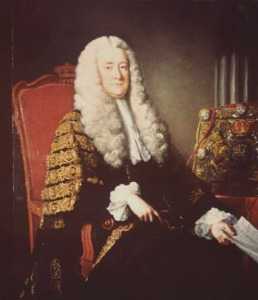
|
| Philip Yorke, Earl of Hardwicke |
When the Duke of York was within hours of being banished, he told his agent Sir John Werden to give the contested strip (now the state of Delaware) to Penn, but save out the town of Newcastle with a twelve-mile strip of land around it. Werden wrote that into the charter with a proviso based on the idea that the fortieth parallel was to the south of Newcastle, when in fact it was fifty miles north of it, and could not possibly conform to the stated boundaries. Both Penn and Baltimore learned the true situation in a year or two, and both attacked the other for dissembling ignorance, each seeking to take advantage of implausible arguments. What in fact they both discovered was that if the dividing line could be pushed a few miles south, Penn would acquire the mouth of the Susquehanna in the Chesapeake Bay, while if it went north a few miles, Maryland would acquire most of Philadelphia. Lord Hardwicke worked out a reasonable compromise which, while ignoring some plain language in the documents, eventually resulted in the Mason-Dixon line which is now reasonably comfortable for everybody, although first subjected to another two decades of wrangle.

|
| Delaware Wedge |
Even part of the eventual compromise, a semicircular northern border, didn't come out right, resulting in a wedge of no-man's land. Landowners didn't enjoy paying disputed taxes, so they held up the settlement of the wrangle into the Twentieth Century. Eventually, the U.S. Supreme Court cut the wedge into two pieces, giving one piece each to Pennsylvania and Delaware. Meanwhile, disputes continued which had their basis in the way the semi-circular line was plotted out on the land. The surveyors ran 120 straight-line radii outward from the courthouse tower in Newcastle, and then connected the ends. Obviously, that resulted in 120 straight chords instead of a smooth semi-circle, and a couple of bulges had to be accommodated where the circle grazed other straight borders. The semi-circle crossed the Delaware River, so New Jersey helpfully abandoned its portion, only to regret its decision later when toll bridges were constructed, and ship channels deepened.

|
| King Charles I |
Two major societal changes took place between 1632 -- when Charles I granted the proprietorship of Maryland to the first Lord Baltimore -- and 1776 when all American real estate changed its rules. The first change was that the Delaware Bay morphed from a swamp into settlements of people; settlers came into possession. The second evolution was to the current view that if you sell some real estate it is no longer yours; in earlier eras, everything belonged to the king, who could take it away and give it to others as often as he pleased. In legal terms, the last king had the last word. Although acres of parchment were scribbled by lawyers pro and con, these considerations are what make clear how Lord Baltimore could hold the unchallenged legal title for fifty years to everything up to the fortieth parallel, but then have a court take away thousands of square miles. A land which was to become the three lower counties of Pennsylvania was given to William Penn by the Duke of York in 1682, using some flawed documents and only fully enjoyed by Penn's heirs for six years until they morphed into the new State of Delaware. From 1684 to 1769, legal ownership was a matter of continuing dispute. The exasperated Lord Chancellor (Hardwicke) in 1750 declared the case as one "of nature worthy of the judicature of a Roman senate rather than of a single judge".

|
| Lord Baltimore |
Lord Baltimore had been given "unsettled" land, occupied only by savages. William Penn's lawyers struggled to prove the Dutch had settled the area before 1632, while Baltimore's lawyers sought to prove that pirates and wandering fur traders don't count, nor do villages of thirty people who were wiped out by the Indians. By the Doctrine of Discovery, taking land from pagans was encouraged, but taking land from Christians required special formalities. Since this Doctrine dates back before there were Protestants, it might have been pertinent to inquire whether the Dutch should be regarded as pagans, as the Spanish surely did when they suppressed Dutch independence in the Eighty Years War, ending in 1648.
Lord Baltimore advertised land along Delaware for sale to settlers while the matter was still under litigation. That was the foulest play said Penn, a weak argument to make if litigation was intentionally pursued for a century.
Maryland favored the Catholic cause, so it seemed plausible for them to want to stall, hoping the Catholic Duke of York would ascend to the throne. Under the new King James II, however, Baltimore seemed unlikely to prevail that the same person, as Duke of York, really didn't own the land he was trying to give to William Penn. So of course, Lord Baltimore claimed he never stalled.

|
| Cape Henlopen |
And by the way, ocean currents moved Cape Henlopen a mile or so southward, but the real boundary problem was that common usage over the centuries confused Cape Henlopen with Fenwick's Island (to which it is usually attached by a thin barrier island), making an implicit difference in the Maryland/Delaware ownership of the corresponding strip of land at the southern border of the State of Delaware, a matter of a hundred or so square miles.
And all of this confusion was merely about the borders of one of the smallest of our fifty states. The political manner in which Delaware became a colony without a charter to the King, and became a state by gradual and mystifying degrees separate from the other counties of Pennsylvania are other complicated stories. Never mind the reasons Delaware remained in the Union during the Civil War, even though it also remained a slave state.
With gratitude to the memory of Dudley Cammett Lunt 1896-1981, whose books are a most readable but scholarly analysis of this complicated history. In particular, The Bounds of Delaware and, for the Mason-Dixon Line, Taylor's Gut in the Delaware State are recommended. The courts rejected arguments that the land was essentially wilderness when Lord Baltimore acquired his patent, and history has been sympathetic to Penn, the winner. The contention was the Dutch owned the land by right of discovery ( a Doctrine applied to land ruled by pagans by Pope Nicholas II in 1454), while the Duke of York later took it from the Dutch by surrender to force of arms -- another legally benign method of acquiring sovereignty. However, Lunt points out that a far more significant issue was the southern border of Pennsylvania in Penn's original grant, which asserted geographical impossibility to replace Maryland's plain and simply defined boundary. History has tended to regard this as understandable error, and subsequent legal quarrels to have been perpetuated by William Penn's greedy heirs. However, Lunt seems to reveal his own opinion of the affair by ending his book with a July 31, 1683 quotation from a letter by William Penn to Colonel Thomas Tailleur:
I, finding this place necessary to my Province and it ye Presence of Ld. Balt. was at Law, civil & common, I endeavoured to get it, & have it, & will keep it if I can.
Go to Delaware, Elephants?
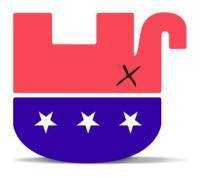
|
| Dead Elephant |
No one is supposed to know where elephants go to die, but if they are smart as people say they are, my suggestion is to search for dead elephants in the state of Delaware. Most taxes, and estate taxes, in particular, are considerably lower, there. At least this was the message Christopher J. Topolewski, Esq. conveyed to the Right Angle Club recently. His firm, West Capital Management, has prepared a table comparing the taxes in the three states that come together at the southeast corner of Pennsylvania, which for residents of the Philadelphia area are within easy commuting distance of each other. Although Delaware has a marriage penalty (one couple is taxed more than the sum of two singles), it has no estate tax at all, no sales tax, and a property tax rate only half that of Pennsylvania, only a quarter of that in New Jersey. For residents of New Jersey, there is almost no tax which is not lower in Delaware, because but ex-Pennsylvanians would then have to be careful to die or cohabit since ordinary income tax and capital gains taxes are higher in Delaware than Pennsylvania. If you must die (and who doesn't?), go die in Delaware.
This was a situation specifically contemplated as a way to discipline greedy state governments, by James Madison when he was formulating the U. S. Constitution. And there is evidence it is working. By happenstance, I once encountered an official of New Jersey taxation, who told me that 43% of New Jersey taxes are paid by 1% of the population. And that 1% was moving out of the state as fast as it could. If it does, the other 99% of New Jersey residents will find their taxes rising by 43%. West Capital reports that taxation as a percent of income is 1.23% in Delaware, 3.46% in Pennsylvania, and 5.82% in New Jersey, suggesting that a selective flight of the 1% would raise the state taxes of everyone else by 43%, and thus make state taxation as a percent of lowered average income rise to roughly 20%. Relating total income to total tax revenues would be an even better way to detect hidden indirect taxes, such as overtaxing utilities in the knowledge it will be passed on to the consumer. I recently discovered that a few years ago, the Legislature got tired of hearing complaints about local taxes, so they transferred half of the local taxes to the state tax. That's pretty much like taking it from one pocket and putting it into another because now all the hubbub is about state taxes. Armed with even partial information, it becomes easier to understand why New Jersey would evict a governor who had been Co-chairman of Goldman Sachs, during a financial crisis. If a financial whiz can't change this, maybe it requires a meat ax.
This is a time of growing restlessness about public spending, and Tea Party revolts are likely to accelerate during the remaining nine months before the next election. The conjecture is growing about a coming deadlock between a Republican Congress and a Democratic President, lasting at least two more years. What might emerge from a strong third party congressional delegation is too arcane to discuss. But at least the Republicans who leave can console themselves they are selectively raising the taxes of Democrats.
It seems almost inconceivable that professional politicians would demonstrate such a forest of tin ears as to let this happen, but the rest of Mr. Topolewski's talk just heated up the fire. His long-scheduled talk was designed to give guidance about the new estate tax laws, but he found himself confounding his audience with the news that there are no new estate tax laws; in fact, there will be no estate tax laws at all after this year unless they emerge from the congressional gridlock we already have. Which apparently will be followed by a gridlock we can scarcely imagine. Imagine asking your lawyer to write a will which straddles the contingencies that there will be no law, that there might be a continuation of the present one, or there might be some new law of quite uncertain wording. One of the suggestions offered is to allow your executor the discretion to accept or disclaim certain hypothetical provisions.
And that brings up an old story. William Penn was the largest private landowner in the history of America, possibly the whole world. He had a trusted agent, who gave him an enormous pile of papers to sign. A busy rich man like Penn is regularly confronted with a discouragingly large number of routine legal documents to sign. So, Penn signed them all, not noticing that one of the various papers in the pile gave the entire state of Pennsylvania -- to his agent. The outcome of the ensuing uproar was that Penn spent six years in debtors prison.
Urban Transportation
Stuart Taylor, who spent twenty years working for the Pennsylvania Railroad in the company of our member Bill Brady, recently gave the Right Angle Club his observations about urban transportation, which grew out of his second career as a consultant. As he describes the evolution from the horse-drawn omnibus carriage to the horse-drawn trolleycar, to the steam-driven trolley, to the electric trolley, to the underground subway, certain parallel historic movements occurred to at least one member of this audience.
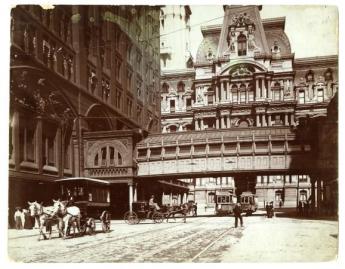
|
| Horse-Drawn Trolley Car |
In the first place, mass transportation is only of value when cities grow to a large enough size to justify the expense. And the growth of cities in the 19th Century was propelled by the Industrial Revolution attracting mass immigration into urban centers. Whether the Industrial Revolution is over or not, is a topic which could be debated, but it was the gasoline engine which made buses and autos attractive, and the decaying slums made cities sufficiently unattractive to cause the flight to the suburbs in the 1920s and 1930s, heavily resumed after World War II in the 1950s. During the heyday of city growth, the evolution of mass transit seemed to be driven by technology, and that in turn attracted private ownership. When the gasoline engine and/or the decline of the Industrial Revolution made the Flight to the Suburbs possible, it made urban transportation unprofitable and hence unattractive to private business owners. Somewhere just before or after the 1929 Crash, the changing situation made it more attractive to live and/or work in the suburbs. A sign of this change in dynamics was the total disappearance of private ownership of public transportation and its supporting infrastructure, and replacement by public ownership and public tax subsidy. As local politics began to reflect this change, Urban politics somehow became dominated by Democrats, and Suburban politics became dominated by Republicans; so the enthusiasm for mass transit has waxed and waned as the political domination of federal subsidies has shifted between the parties. That's probably only an outward sign, however. The real issue is that urban transportation now has to be subsidized since its base has shrunk to the point where people like Widener and Elkins invest in other things. And do so from their homes in exurbia, where the neighbors could care less about subways, let alone pay taxes to subsidize them. And until the city gets control of its crime, public schools, and taxes, it's hard to see what will attract them back in town.
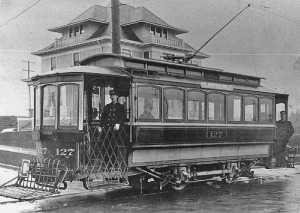
|
| Electric Trolley |
That's perhaps an overly censorious view, coming from a resident of the suburbs. A more economic view of things would be that the construction of underground subways now costs about a billion dollars a mile. Very few cities and no private entrepreneurs can justify costs of that magnitude since the potential ridership cannot afford the costs per ride which are implicit in that capital expenditure. Until the cities can manage to entice the suburbanites back into town, those people will solve their air pollution problems by avoiding the cities. Living to the windward seems much more plausible to them. China is just beginning this process, but they have the advantage of building the subways first, then the surrounding skyscrapers, and thus greatly reducing the costs of avoiding underground sewer systems, etc. If you could call it that, the Europeans had the advantage of massive war destruction, along with much more expensive farmland to inhibit suburbanization. None of this is an argument that we shouldn't build subways, or clean up the atmosphere. It's just a warning of the daunting construction costs and staunch political opposition to mass transit. Not to mention featherbedding, over-hiring, massive hidden benefits costs, and other features which seem to be inherent in union activity, at least of the historical variety.
A member of the Right Angle audience asked the speaker what he thought of the proposed Market Street light rail line. Insane, was the answer. No visible ridership. And that seemed to summarize the present debate.
Except that it really shouldn't frame the argument for Philadelphia. Philadelphia doesn't need a mass transit network, it already has a mass transit network. Much of it is growing obsolete, but the land costs and local opposition to change are greatly diminished when the network is already there. If any city can do it, Philadelphia can. The technology will surely evolve enough for our purposes if the money is there, and the money will be there if people return to using the city. What Philadelphia needs is a return of business headquarters and other sources of employment, bringing the ridership and the public demand along with it. And for that, what is essentially needed is for government to address our problems of uncontrolled crime, inferior public schools and maladministered taxes.
Paying for College I
It's almost two platitudes that during the Nineteenth century America changed from a largely agricultural nation into a largely industrial one. And toward the end of the Twentieth century, we are going on from an industrial economy toward a service economy. This latest shift of direction is one of the main causes of soaring college tuition costs. Demand for first-class college education grows faster than price increases, competition, and internal efficiencies can seemingly control.

|
| College Cost |
Tuition costs at the top of the educational pecking order have now reached $52,000 annually, with room and board and other costs sometimes adding another fifteen thousand. Attending college already costs well in excess of the average after-tax income of working Americans, perhaps even in excess of the average income of college graduates. College costs regularly exceed the disposable income of undergraduates' parents and must be temporarily subsidized while the nation collects its wits, but subsidy cannot be a permanent solution to a problem so large. Average incomes of college graduates do exceed the average income of those who only finish high school. That extra income is gamely said to justify the investment, even taking into account the invisible loss of 4 years of earnings, perhaps even a trailing six-figure indebtedness. However, a meaningful score can only be toted up in retrospect, after inflation and taxes work their way into a net-net appraisal. Faith in some postulated answer to this accounting puzzle colors various belief systems, like: How much should we worry about widening income gaps between any income segments? What is the particular value to society of income redistribution between those who pay full tuition and those who receive financial aid?. There could be legitimate questions about many other values throughout the whole system. During the Vietnam War, many uncomfortable questions were raised about the educational system, even leading to riots on college campuses. It was often implied that many students were in college merely to escape the military draft. While that may have been precisely what was in many minds, the scramble for elite college admissions has intensified since the end of the draft, seemingly proving a college education has other merits. Steadily rising tuition costs are rapidly narrowing the income advantage, so one supposes the intrinsic merits of higher education can soon be measured by whatever enthusiasm for admission survives the bursar's bite. There are a few reasons for doubt, many reasons for anxiety.
In the first place, undergraduate tuition charges are poorly related to underlying instructional costs. It is natural to expect some markup for any product on sale, and some cushion for the unexpected. However, the difference between the tuition for night school and day school is a pretty disconcerting example. Comparatively few universities offer the same undergraduate courses as night-school courses, but a number of them do. The tuition for regular undergraduate courses is about average, somewhere around $5000 per course, but the tuition for night school is around $1200 per course -- same teacher, same textbook, same exam. Without access to the accounting data, one is led to suppose the tuition for night school comes pretty close to the true instructional cost of these courses. And therefore led to the supposition that the 300% markup for undergraduates implies that undergraduates, blue jeans and all, subsidize a great deal of unrelated activity throughout the university. This sort of discovery does not enhance the image of justice in academia.
In the second place, colleges can as easily re-direct surpluses into the endowment fund as out of it. They batter the concept of donor intent in both directions, breaking the linkage of tuition to underlying costs, and the linkage of donations to needs. Ultimately universities may be defined as mere steps to a higher income for wise investors, and cannot complain if proof of adequate return is demanded. Such accountability might even be a wise precaution, based on observation of the way Great Britain has made Oxford and Cambridge dependent on government subsidy, then subsequently allowing class warfare antagonisms to degrade the government contributions. These prestigious universities are now much humbled by transforming income inequality into a mark of shame. Unless American universities are designed to follow the same path, they will be forced to choose between competing for the way businesses do, or the way churches have traditionally done. Unfortunately, there is a reason to fear which was a college president will tip, with a cash register in one hand, and a begging cup in the other.
America is almost unique in its large proportion of small liberal arts colleges. No doubt, many of them would prefer to remain as they are, but it seems attractive to encourage thirty to fifty of them to become universities. When asked the differences, one college president replied the main difference is the presence of graduate students. Judging from the competitiveness of admission, the demand for graduate students is much closer to supply than at the undergraduate level; some tuition distortion reflects an effort to increase the supply of college teachers. Income prospects after graduation are probably an influence, but since the main occupational opportunity for graduate students is to teach undergraduates, increasing the openings for college graduates in a service economy must also imply matching the increase with more people to train them. However, only a minority of university undergraduates go on to become graduate students, so creating fifty universities also rebalances the incentives to become teachers. There are observers who advocate replacing teachers colleges with universities, a proposal which necessarily collides with the present informal dual-track system. High school teachers are mainly trained in teachers colleges, while university professors are products of graduate schools. The two streams are kept carefully separate because the commotion created by mingling them would probably be considerable. Nevertheless, this may be the rate-limiting step which will have to be addressed.
Mention of secondary education must be made, however, in order to grapple with the issue of automating education. It must be obvious that one distinguished Shakespearean scholar could replace thousands of lesser teachers of the same subject by the use of video recordings of the distinguished lecturer at work, both for introductory college courses and more advanced levels in high school. True, a small handful of pure scholars needs to be segregated away from the mass of college teachers, most of whom might prove to be graduate students. Face to face interaction is essential at every level of education of course, but automation holds such huge financial promise that greater experimentation and innovation seems inevitable. The education industry needs to make much more strenuous efforts to reduce its costs through greater adaptation to information technology if only to improve its ability to teach such adaptations to entrants into other industries. Shortening the school year, wider expansion of the Junior year abroad, and employing graduate students to teach, are debatable methods for reducing the cost of education; but an enthusiastic embrace of the computer revolution must improve educational quality before other nations leave us in their dust.
And finally, caution must be mentioned. Some degree of specialized focus of college courses is inevitable; we cannot develop scientists and engineers without it. But we must not eliminate the liberal arts, carelessly calling them luxury in a busy age. To a probably excessive degree, universities have replaced religions as a secular place to examine and teach young people how to live and behave. In little more than a generation, universities have a determined (long) hairstyle and (blue jeans) dress style, sexual morals, and political belief systems, mostly in a libertarian direction. That is not why we have colleges, or at least not why students must pay a quarter of a million dollars to experience them. There is another layer of intangible value in a liberal education, perhaps only perceived by personal experience. As I look back on a great many decades, I realize that almost every important step upward in my life was unexpected, almost unwelcome. Someone came out of the blue and offered it to me. Other people were watching and judging from behind some social bush. By contrast, almost every advancement that was strived for mightily, perhaps even a little too competitively, was to some degree gratuitously thwarted by others, often quite openly. Unobserved headhunters are watching for many qualities, particularly the ability to play this game. Spending some extended time learning what our society is all about through liberal education is a technique for self-advancement, too; universities would impair their customers' main chances in life by disturbing it.
Paying For College - II
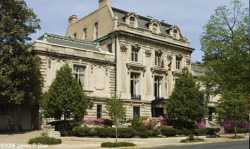
|
| The Cosmos Club Washington D.C. |
To begin with an anecdote, I belong to a Philadelphia club which reciprocates with the Cosmos Club in Washington DC. It's a handy place to stay overnight on the rather infrequent occasion of visits to Washington on business. It happened I had an early breakfast at the Cosmos and was the only guest in the dining room. A pleasant well-dressed man came in and asked if I minded if we sat together. "I'm Bob Goheen. I work at Princeton." Since he was widely known as the President of Princeton University, he was indeed welcome. He could hardly be expected to know my daughter was then a sophomore at his college, so he was, of course, unprepared for what I had to say.

|
| Empty Pockets |
After introductory pleasantries, I told him of my arithmetic problem. My daughter was taking five courses, so the family was paying ten thousand dollars a year, per course. Since most of her courses had over two hundred students in the lecture hall, the University was being paid two million dollars to teach each course. Was it possible I had got the arithmetic wrong? Mr. Goheen neither flushed nor displayed hostility, but his manner did change. Well, of course, the tuition pays for far more than direct teaching costs. It's expensive to maintain a first-class library, the University has a responsibility to help the town of Princeton with its problems, the University is proud of its very extensive scholarship program for needy students, there is research to be sponsored. Yes, said I, you have fallen into the trap I prepared for you. My complaint is that if I had donated money for those worthy causes, it would all be tax-deductible; but by having it extracted from me under the name of tuition, I was denied the tax advantage. As expected, he quickly changed the subject. And to his evident relief, I let him do so without resistance.
Since that time, I have had the opportunity to play the same game with several college presidents; not all of them have been suave about it. The only one who took me by complete surprise was the President of Lehigh University, who not only told me he agreed but added that he had made himself unpopular with his peers by promoting exactly similar ideas. There is a very serious problem, here. Somehow, the higher education industry has got to engage in some statesmanship because it is only a matter of very short time before someone proposes a government solution.

|
| National Institutes of Health |
It is possible to treat this issue as a problem of how to pay for universal college education, which would put it in a category now occupied by health care, and probably reach a political impasse for similar reasons. Or it could be treated as a problem of teasing apart the instructional costs from the research and scholarly costs. The problem to be solved, viewed from this latter direction, assumes that excellent teaching could occur, isolated from the scholarly activities, in the manner now accepted for secondary and elementary teaching. Conversely, research institutes with no teaching responsibilities are widely accepted in Europe, for instance, while in America the National Institutes of Health are their most prominent example of its workability. It can be argued that a scholar engaged in research makes a better teacher; it can also be argued that talent for teaching is not necessarily found in those with a talent for research. While it is true that some researchers are productive even in old age, for the most part, research is like poetry and sports, a young person's game. A creative scientist can usually look forward to acting as an administrator after reaching a certain age; why not instead look forward to a career in teaching? There appears to be no serious problem with this suggestion, except the nontrivial issue of relative prestige linked to ascending income. In summary, the question is whether we can afford to put another Harvard in every town of a specified size, or whether we will be forced to transform most existing colleges into enlarged high schools, as we build more of them. Obviously, that's a cheaper method, the question is whether it is a good enough product. Whatever the model to be mass produced, the overall cost would be reduced by stripping out populations who do not need so much education, and getting Google or IBM, or someone similar, to apply massive amounts of information technology to reducing the cost. In achieving universal health care, by contrast, we can reasonably foresee research reducing most of the delivery costs we now contend with, even eliminating some of the major diseases. In education for a service economy, the potentially increasing educational need is unfortunately endless.
Therefore, no matter what pattern we adopt, it must be organized to be in competitive tension with the manpower needs of the economy, rather than unmeasurable goals like becoming well rounded. If the reason we need a vastly more educated population is to supply better-educated graduates to run the economy, some kind of tension must exist between the two, or the educational establishment will ruin us with purposeless expansion, just as some elements of the healthcare industry might wish to do with their services, and almost all trial lawyers unashamedly wish for in their area of expertise.
In this area of economic design, lies the answer which President Goheen should have made to me in the Cosmos Club. By asking for a massive tax deduction, I was yielding to the idea that education was always a responsibility of government, always paid for by rejiggering the tax code. In that direction lies disaster, since control of the tax code lies in the realm of politics and leads to populist solutions. We must not unbalance power relationships so that economic leaders, asking for a better-educated workforce, are not eventually confronted with crippling taxation for the betterment of bloated academia. A typical college has as many employees as students. We cannot get caught up in an unrestrained process leading to half of the population teaching the other half, except for those who have retired and receive a pension from both activities. Rather, this expensive quest for quality must be seen as the other half of the immigrant's dream, which is no longer that of average performance in an industrial economy, but rather that of excellence in a service economy.
Heron Rookery on the Delaware
 |
| Great Blue Heron |
When the white man came to what is now Philadelphia, he found a swampy river region teeming with wildlife. That's very favorable for new settlers, of course, because hunting and fishing keep the settlers alive while they chop down trees, dig up stumps, and ultimately plow the land for crops. As everyone can plainly see, however, the development of cities eventually covers over the land with paving materials; it becomes difficult to imagine the place with wildlife. But the rivers and topography are still there. If you trouble to look around, there remain patches of the original wilderness, with quite a bit of wildlife ignoring the human invasion.
 |
| Heron Nests |
Such a spot is just north of the Betsy Ross Bridge, where some ancient convulsion split the land on both sides of the Delaware River; the mouth of the Pennypack Creek on the Pennsylvania side faces the mouth of the Rancocas Cree on Jersey side. In New Jersey, that sort of stream is pronounced "crick" by old-timers, who are fast becoming submerged in a sea of newcomers who don't know how to pronounce things. The Rancocas was the natural transportation route for early settlers, but it now seems a little astounding that the far inland town of Mt. Holly was once a major ship-building center. The wide creek soon splits into a North Branch and a South Branch, both draining very large areas of flat southern New Jersey and making possible an extensive network of Quaker towns in the wilderness, most of whose residents could sail from their backyards and eventually get to Europe if they wanted to. In time, the banks of the Rancocas became extensive farmland, with large flocks of farm animals grazing and providing fertilizer for the fields. Today, the bacterial count of Delaware is largely governed by the runoff from fertilized farms into the Rancocas, rising even higher as warm weather approaches, and attracting large schools of fish. My barber tends to take a few weeks off every spring, bringing back tales of big fish around the place where the Pennypack and Rancocas Creeks join Delaware, but above the refineries at the mouth of the Schuylkill The spinning blades of the Salem Power Plant further downstream further thin them out appreciably.
Well, birds like to eat fish, too. For reasons having to do with insects, fish like to feed at dawn and dusk, so the bottom line is you have to get up early to be a bird-watcher. Marina operators have chosen the mouth of the Rancocas as a favorite place to moor boats, so lots and lots of recreational boaters park their cars at these marinas and go boating, pretty blissfully unaware of the Herons. Some of these boaters go fishing, but most of them just seem to sail around in circles.
 |
| As Seen From Amico Island |
Blue herons are big, with seven-foot wingspreads as adults. Because they want to get their nests away from raccoons and other rodents, and more recently from teen-aged boys with 22-caliber guns, herons have learned to nest on the top of tall trees, but close to water full of fish. And so it comes about that there is a group of small islands in the estuary of the Rancocas, where the mixture of three streams causes the creek mud to be deposited in mud flats and mud islands. There is one little island, perhaps two or three acres in size, sheltered between the river bank and some larger mud islands, where several dozen families of Blue Herons have built their nests. One of the larger islands is called Amico, connected to the land by a causeway. If you look closely, you notice one group of adult herons constantly ferries nest building materials from one direction, while another group ferry food for the youngsters from some different source in another direction. At times, diving ducks (not all species of ducks dive for fish) go after the fish in the channel between islands, with the effect of driving the fish into shallow water. The long-legged herons stand in the shallow water and get 'em; visitors all ask the same futile question -- what's in this for the ducks? The heron island is far enough away from places to observe it, that in mid-March its bare trees look to be covered with black blobs. Some of those blobs turn out to be heroes, and some are heron nests, but you need binoculars to tell. When the silhouetted birds move around, you can see the nests are really only big enough to hold the eggs; most of the big blobs are the birds, themselves. There are four or five benches scattered on neighboring dry land in the best places to watch the birds, but you can expect to get ankle-deep in the water a few times, and need to scramble up some sharp hills covered with brambles, in order to get to the benches. In fact, you can wander around the woods for an hour or more if you don't know where to look for the heron rookery. Look for the benches, or better still, go to the posted map near the park entrance south of the end of Norman Avenue. There are a couple of kiosks at that point, otherwise known as portable privies. Strangers who meet on the benches share the information supplied by the naturalists that herons have a social hierarchy, with the most important herons taking the highest perches in the trees. That led to visitors naming the topmost herons "Obama birds", and the die-hard Republicans on the benches responding that the term must refer to dropping droppings on everybody else. That's irreverent Americans for you.
There is quite a good bakery and coffee shop just north on St. Mihiel Street (River Road), and the new diesel River Line railroad tootles past pretty frequently. That's the modern version of the old Amboy and Camden RR, the oldest railroad in the country. It now serves a large group of Philadelphia to New York commuters, zipping past an interesting sight they probably never realized is there because they are too busy playing Hearts (Contract Bridge requires four players, Hearts are more flexible). However, there's one big secret.
The birds are really only visible in the Spring until the trees leaf out and conceal them. Since spring floods make the mud islands impassible until about the time daylight savings time appears, there remains only about a two-week window of time to see the rookery, each year. But it is really, really worth the trouble, which includes getting up when it is still dark and lugging heavy cameras and optics. Dr. Samuel Johnson once remarked that while many things are worth seeing, very few are worth going to see. This is worth going to see.
And by the way, the promontory on the other side of the Rancocas is called Hawk Island. After a little research, that's very likely worth going to see, too.
What's Different About Kosher ?

|
| Kosher Foods |
About half of the labeled food products in a typical supermarket are designated Kosher, displaying a "K". That seems remarkable when only about 1 million American Jews are observant or Orthodox, thus eating only Kosher food for religious reasons. So, the Chemical Heritage Foundation recently decided it would be interesting to examine the definition and details of the Kosher designation, which presumably has some chemical basis. The CHF was right about the interest in the topic; attendance at the auditorium was packed. The following is entirely derived from what was discussed there.

|
| Rabbi |
One might have carelessly supposed that a religious designation of food products would have an exclusively religious basis, probably related to preparing the product according to a religiously defined method or ceremony. That's essentially true, but what is unexpected is that the choice of food to be included or excluded must obey a strict and extensive set of rules. The basis for the rules is found in the Old Testament, but specifics have been evolved by designated Rabbis, rather like the way the interpretation of the U. S. Constitution is left to the U.S. Supreme Court, and has considerably evolved in the process. An examination of these evolved rules is what leads other denominations of Jews to avoid the issue or even to decline to endorse it. That makes it rather awkward for chemists to understand the Kosher process in strictly chemical terms. For a perhaps extreme example, hard cheese but not soft cheese is strictly forbidden within Kosher rules. That's because the rules state that eating meat is fine, eating cheese is fine, but six hours must elapse between eating either one. What's forbidden, then, is a mixture of meat and dairy. Hard cheese is produced by exposing soft cheese to rennin, or rennet. Rennin is produced from the stomach of cows, so the interaction is deemed to be simultaneous rather than separated by more than six hours. It certainly is true that a chemical reaction between two ingredients is difficult to imagine if it is anything but a simultaneous contact between the two. So, chemists would have to agree that hard cheese involves less than a six-hour separation between meat and dairy. But most chemists would regard this interpretation to be somewhat strained; to punish people for disregarding it seems excessive. Whatever disagreement there may be is not based on the facts, but on the importance to be attached to them.
Similarly, most chemists would resist the idea that a chemical product derived from two different sources differs in any way at all. The most important example of this issue is glycerine, a common food additive. A fat consists of three fatty acids attached to glycerin; pure glycerin is produced by separating the fatty acids from it, and in any event, the fatty acids of pigs and cows are also chemically identical, at least in the view of chemists. Glycerin derived from pig fat thus seems to chemists to differ in no meaningful way at all from glycerine derived from cow fat. To those in charge of Kosher rule making, however, the difference in the source is vital, needing to be searched out in minute detail. Since Coca-Cola contains traces of glycerin, and the Coca-Cola manufacturer wished to have a Kosher label, the company somehow had to satisfy the Rabbinical demand that the sources and processing steps of the glycerin be identified in minute detail. Coca-Cola contains a secret ingredient which some believe is essential for the true Coke taste; the company was not going to reveal its processes. Somehow, this quarrel was resolved privately, although it is not easy for outsiders to imagine how it could be.
And so on. There may, of course, exist many Kosher rules which make perfect sense; the speakers did not go into that. What remains of general interest is the question why so many non-Orthodox Jews, in fact so many people who are not Jewish in any sense, insist on eating only food with a Kosher label. At the conference, it was explained that many people who have been told they are lactose-intolerant, or allergic to some protein, become fanatic in their fear of contact with such chemicals. That is, as a matter of fact, a common observation in many doctors' offices. These people seem to have developed the idea that they can trust the Orthodox rabbis to be even more fanatic than they are if anything more rigid and unyielding in their pursuit of particular exclusions. While that has driven many Jews away from Orthodoxy into other religious directions, it has served to reassure the health fanatics. The food manufacturers don't particularly care about the social features; if that "K" sells the product, they want to have it.
On hearing of these issues, one of my Jewish friends suggested an extension to Jewish kitchens. It was his view that if a real estate agent shows you a house with two or more ovens, two or more stoves, or even two or more kitchens, it probably had a Jewish owner at some time in the past. Multiple kitchen arrangements are much less likely to reflect an owner who likes to entertain a lot, than an owner who has been told of the six-hour mandatory wait between eating both meat and dairy, and has persuaded himself this rule extends to the separation of stoves. There's no great harm in any of these beliefs, of course, unless it is somehow represented that they improve the health of the believer, which would drag a highly reluctant Food and Drug Commissioner into a dispute he can't win, no matter how he rules.
Whatever the complete truth of all these suppositions, they lead the casual reader to let his thoughts meander. There's a similarity here to a great many other prohibitions and adherence, tenaciously adhered to, resulting in elections won and lost, provoking scorn heaped on non-believers. And even to totally unrelated legislation getting derailed because legislative representatives were unwise enough to take a stand on this one. Pro or con.
Cushman Club for Lonesome Actresses
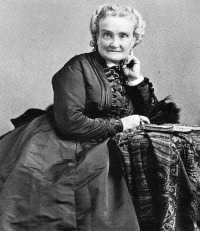 |
| Charolotte Cushman |
Lydia Ellicott Morris was married to another member of the Quaker colonial aristocracy, George Spencer Morris; both of them were active members of many organizations, including the Philadelphia Savings Fund Society, Friends Hospital, and several of the clubs on Camac Street. Their home for many years was located at 225 South Eighth Street. George Morris was a senior partner of Morris and Erskine, Architects. One day, Lydia was riding on a trolley car.
On the trolley, she overheard two young actresses fretting over the problem that traveling actresses were forced to live in hotels and boarding houses along with traveling salesmen. This circumstance forced them to experience much-unwanted attention and made being an actress a difficult occupation for respectable women. Lydia promptly got off the trolley and formed an organization raising funds to create in 1907 a boarding home to provide safe, respectable, inexpensive lodgings for actresses in traveling shows, playing in Philadelphia. It was named after Charlotte Cushman, the first internationally famous American actress, and located at 1010 Spruce Street. Charlotte Cushman had no connection with the club, but her fame can be appreciated from the fact that in 1874 after her final performance, 15,000 people were reported to have serenaded her outside of New York's Fifth Avenue Hotel. The Ninth Regimental Band played, while fireworks illuminated Madison Square. Ms. Cushman died in 1876.
Another major donor to the club was a Mr. Peterson, otherwise unidentified, who gave them $50,000. Further funds were raised at five annual teas. In 1925, Philadelphia was a major center for the film industry, and much Charlotte Cushman Club early history relates to movie associations. Much of the early endowment was unfortunately lost in the 1929 stock market crash, however, and the club continued only a subdued presence for a number of years. By 1999, it was clear that the original purpose was not really needed, and the club was disbanded. Its possessions, including the last of several clubhouses, the collections, and a rather valuable library, were sold off, and most of its other belongings were donated to the Franklin Inn Club. The club began a new existence as the Charlotte Cushman Foundation, first endowing the Charlotte Cushman Board Room and Exhibit, at the University of the Arts, and then in 2001 began making grants to local nonprofit theatre groups. At present, the Foundation dispenses an income of about $45,000 yearly among 43 non-profit theatrical societies which continue in Philadelphia. Present dominant activity is to select the Leading Actress in a Play, as part of the annual Barrymore Awards. The rise of the club reflected the vibrant downtown social life of Philadelphia at a time when almost all Philadelphians were residents of the center city. And its decline parallels the loss of civic-minded center city residents following the spread of household automobiles and the continuing wreckage of traditional civic feeling following the 1929 crash.
The Foundations's website is www.charlottecushmanfoundation.org, and its email address is CharlotteCushmanFoundation@gmail.com
Pipe Organs, and Similar
The Franklin Inn Club was pleased to hear a talk about pipe organs the other evening, by one of its members, Wesley Parrott. Wesley has degrees in the subject from the Curtis Institute and Eastman and was accompanied by Riyehee Hong, who has a Ph.D. degree on the subject from the Moore College. Wesley is now the organist at St. Mary's Church on Cathedral Avenue.

|
| l'Orge de Valere |
The flute is just about the oldest musical instrument if you regard a pipe organ to be essentially a large collection of flutes with a single mechanical air blower, controlled by a console. Bagpipes almost fit that description, too, except a bagpiper first fills the bag with air he blows in by himself, and fingers the holes in the pipes for individual notes, whereas the pipe organist has mechanical assistance to supply the air and control the pipes.
It seems to have been Emperor Charlemagne who decreed the pipe organ would contribute the main music of churches, and to fit this role, pipe organs in France and Italy evolved in the direction of elaborating the overtones and color characteristics of the organ as sort of a soloist in a church. Organs from this distant era are still playable but seem tiny in comparison with later examples. German music, in general, has always emphasized melody over elaborate overtones, and German organs evolved in the direction of distinctive notes in counterpoint. That has been true for centuries, but it was the missionary surgeon Albert Schweitzer who most recently made great steps away from French influences back toward melody and counterpoint, both in musical composition and in mechanical modifications of the instrument to suit that baroque goal. The mechanical underpinning of this distinction lies in the immediacy of response and shortening of tone decay, making the notes crisper. The older French version tends to smear the notes together, like a young person who talks too fast. The whole French language shares that characteristic of slurring words together, and speakers thus seem to be talking a little too fast to be understood. The German language is more staccato, with distinct separate words. In general, pipe organs tend to be either of the French or the German style, but there is a great deal of individual variation, resulting in subtle distinctions lost on most audiences. The design and construction of organs remained essentially unchanged from 1390 when l' Orge de Valere" was published by Guy Bovet, until 1876, when the great modern innovation of the electric organ was displayed in Philadelphia.
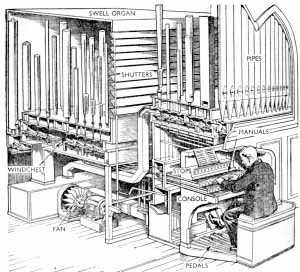
|
| Pipe Organ Sketch |
In fact, two modern changes were heavily American-influenced. The most important change in the mechanics after five hundred years was introduced at the 1876 Centennial Exposition in Philadelphia, by Hilborne L. Roosevelt, a cousin of Teddy, and son of S. Weir Roosevelt. The organ on display was the main organ of the main exposition building and created a sensation. Although he was only 37 years old when he died ten years later, Roosevelt became one of the largest organ manufacturers in America, a friend of Thomas Edison, and was recognized for a number of electrical inventions. Electrical control of the blower and valves greatly expanded the potential for size and complexity of the keyboard console. Up until that time, the keys were pounded with the organist's fists, and organists therefore somewhat resembled blacksmiths, both in musculature and temperament. The application of electricity greatly expanded the complexity and artistic potential of both the German and French styles. Meanwhile, the symphony orchestra was evolving throughout the 19th Century, and now the organ was able to imitate the whole orchestra. This evolution soon developed a mass market in the huge silent movie theaters of the early 20th Century, which in turn generated a pressure to evolve orchestra-like characteristics in the organs installed in the theaters, adding extra pipes and tones to suit that taste, which was exuberant. The advent of sound movies would soon eliminate the need for pipe organs in movie houses, but the instruments were durable and built into the walls. A few of them therefore still remain, largely unused, and probably unusable. The Philadelphia region is unusually rich in pipe organs of various sizes and complexity; students of the subject come here to tour them.
Philadelphia's Kimmel Center has a new pipe organ, with two consoles to suit the two main styles of organ music, solo of the Charlemagne sort, and orchestral music. Wesley feels too much emphasis was placed on maximizing the seating capacity of the Kimmel auditorium, causing the organ to be fitted into a narrow tunnel-like enclosure. The resulting sound of the organ has a uni-directional quality which is unrelated to the organ itself; some people criticize the overall result as "assaulting" the audience, but whether for better or worse the Kimmel Center distinctively has a Kimmel sound.
The electronic organ, as distinguished from the electric organ, doesn't use pipes, it synthesizes sound. It is far cheaper to manufacture, but is undergoing such rapid change in so many directions nowadays that it resembles the home computer; you have to go to the expense of getting a new one every few years. The electronic organ is clearly catching up with the range and quality of pipe organs but has not yet reached parity except in specialized situations. But its rapid and relatively inexpensive adaptability gives it a great advantage when musical tastes are changing. Modern music places much more emphasis on percussion, and modern society is much less attracted to great big hollow churches. Electronic organs thus change direction faster than multimillion dollar organs of the traditional sort, and slowly, slowly, the quality is catching up, too.
Pets For all Seasons
People who have had a chance to talk with Queen Elizabeth report she is so fond of the Korgi dog pets that she scarcely talks about anything else. Perhaps because he is British, then, Professor James Serpell seems natural to have been elected chairman of a new department at the University of Pennsylvania Veterinary School, devoted to the study of Human-Animal Interactions. In any event, he made an interesting presentation to the Right Angle Club recently, reviewing the history of acquiring pets. A domesticated animal is not necessarily a pet; chickens and cows raised for food purposes are not considered real pets. A pet is domesticated purely for the purpose of companionship and love. Study of cave paintings and fossils seems to show that pets were maintained for many years before animals were domesticated for food purposes, although hunting dogs might have utility beyond providing love and companionship. The ancient nature of pets does seem to suggest purposes other than utility have been prized for a very long time, and not exclusively by people who are affluent.
Pets are steadily increasing in number, however, and are estimated as approaching 160 million, a number growing faster than the human population of the earth. The human residents of the earth are just about the only species known to make pets of other species, although monkeys will occasionally treat marmosets in a pet-like way. There might still be some utilitarian purposes in keeping pets, however; a goat companion is observed to have a calming effect on wild horses. For something whose utility is marginal, pets are a pretty expensive hobby. It is estimated that $45 billion is annually spent on them. A non-pet lover was once heard to remark that a cat is a domesticated parasite. Apparently, you either love pets or you don't.
It probably hasn't much to do with the motives of pet-lovers, but research does seem to show that those who maintain pets live longer than those who do not, whether the pet is a cat, dog, or rabbit. Pet owners have lower average blood pressure and score better on tests which reflect the prevailing stress level. In spite of snide remarks sometimes heard about people who love pets better than their neighbors, tests of interpersonal relationships actually seem to favor pet lovers.
In recent decades, there has been a growing tendency to confer rights, animal rights, on animals in general, and pets in particular. Remarkably, animal rights advocates seem to be more common in urban environments, than in rural ones. Perhaps the experience of wringing a chicken by the neck in order to prepare dinner hardens the heart. Next thing you know, the Tea Party phenomenon will start getting blamed on observations like this, so watch your language, please.
Thieves of Baghdad

|
| Col. Matthew Bogdanos |
Col. Matthew Bogdanos, of the U.S. Marines, gave an interesting insight into what the Baghdad Museum really was, how it was captured, and how the treasures were recovered, at the University of Pennsylvania Museum the other night. Our own museum is said to be the second largest archeology museum in the world, after the British Museum. After discovering what was really in the Baghdad museum, that ranking may have to be revised; but the chief Philadelphia interest traces back to the discovery of the ancient city of Ur by Philadelphia archeologists during the last century, an event which essentially created the University Museum. This was where civilization began, and we discovered it.
The reserve Colonel happens to be a prosecutor for the New York District Attorney, was trained extensively in classical antiquities; and so was the perfect point man to lead the capture of the Museum during the Iraq war, very well suited to follow the looted treasures into the international antiques market -- and recover substantially all of it. Something like 62,000 pieces were recovered, and all of Nimrud's Treasure, the prize possession of the museum.

|
| The Baghdad Museum |
There has been criticism of our troops -- some of it right out of this evening's Philadelphia audience -- for allowing the place to be looted in the first place. But that sort of assumes the place was lying vacant and undefended while our troops were out shooting innocent civilians. That's a misapprehension quickly dispelled by videotaped scenes of real live shooting and rockets coming out of the place at the time, which the Colonel was happy to display. Questioners were invited to claim they would have been willing to go into that hornet's nest in order to save alabaster statues, but others in the audience inclined to giving the Marines some benefit of doubt.

|
| Hussein Millions |
That place was vandalized when the troops got into it; to say it was thoroughly vandalized is only true in a sense. There was indeed a lot of looting, but the bigger surprise was to find there were hidden storage rooms behind steel bank doors, filled with the really best antiques, as well as vast boxes of American hundred-dollar bills. By weighing the hundred dollar bills (22 pounds for every million dollars) it was estimated that Saddam Hussein had about $800 million in U.S. currency stored in that one place. Gold as a raw commodity has since gone up considerably in value, but many of the best antique gold pieces on display in the museum were only copies, the originals were kept in the secret vaults. The international market appraises quite a few of these pieces at over $10 million apiece. Apparently, the thieves knew exactly which pieces were valuable, and went straight to them without even pausing to notice other rooms full of objects of lesser value. The museum had been closed to the public for the previous twenty years; it seems rather obvious that Saddam was storing these objects in order to buy weapons for continuing guerilla activities underground, or in exile. The museum itself consisted of nearly twenty separate buildings in the center of Baghdad, and the custodians obviously must have known where things of serious value were kept, in order to get to them so precisely.

|
| Nimrud's Treasure, |
Offering an amnesty, no questions asked, brought in thousands of recoveries from the local public. Getting other pieces back from art galleries in London, Geneva and Berlin required methods that were not described in detail. Some of us who remember the German and Japanese mementos which were "liberated" during World War II have an immediate appreciation of the improved American troop discipline which must have been imposed in the Iraq War. That's something to think about, too. Our troops had been given extensive training to respect the cultural heritage of the enemy, and they evidently did so to a remarkable degree. One certainly has to doubt that Saddam was locking that material in vaults for twenty years in order to preserve the culture of any sort. If it had any other purpose than to serve as a way of transforming oil wealth into munitions, it's a little hard to imagine what it was.
Unalienable Rights Before 1776

|
| Magna Carta |
In 1976, the bicentennial birthday celebration of the Declaration of Independence contained two major exhibits of its conceptual origins. Mr. H. Ross Perot of Texas loaned his copy of the 1215 Magna Carta, and the Proprietors of West Jersey loaned their 1677 original of William Penn's Concessions and Agreements to the colonists of New Jersey. The purpose of the exhibit was to emphasize the historical origins of the concepts within the Declaration, but even the language of the Concessions is remarkably similar, quite evidently lifted by Jefferson when he was writing. On one point, Penn had the better of Jefferson; he correctly wrote about inalienable rights, while somehow Jefferson gave us unalienable ones.
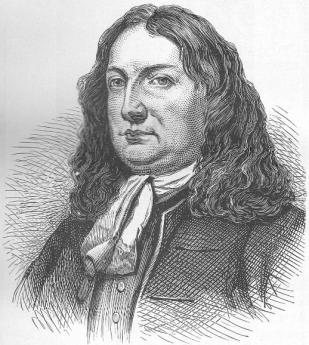
|
| William Penn |
The matter came up recently at a Socrates meeting of the Right Angle Club, where at least one member felt there was no such thing as a natural right, while others wavered. In discussing the rights which the Creator, William Penn and/or Thomas Jefferson may have given us, the various contexts must be held in mind. At the time of declaring our intention to sever relations with Britain's King, there was no Constitution to refer to as a source, and it was impolitic to assert the rights had been given by English kings, like King John. Therefore, the language cleverly short-cuts around the divine right of kings to make a direct connection between the Creator and the colonists. William Penn on the other hand, was a real estate promoter, offering enticements and assurances to prospective colonists who were naturally fearful of risking their lives in sailboats, only to face the possible tyranny of a vassal king who might be even worse than the anointed one. Not only did Penn renounce any suggestion of a Royal role for himself, but went to considerable length describing the legally binding concessions and agreements he was offering. The right of trial by jury, for example, became a right to be punished only by a jury of twelve of one's neighbors. He wasn't talking to lawyers, he was making important distinctions very clear to laymen. These were not rights given by a Divinity who could be trusted, nor something which grew out of Mother Nature. They were the personal promises of William Penn, in personal legal jeopardy of the English courts if he reneged on them. He even had a ready answer for those who discovered the religious language in legal documents -- the Quaker belief that, occasional appearances to the contrary notwithstanding, There is That of God, in every man.
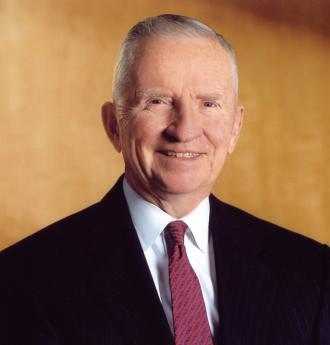
|
| H. Ross Perot |
As a small sidelight of the Concessions document, it had long been housed in the little brick hut on Main Street in Burlington NJ, where the Proprietors of West Jersey keep their treasures. The obscurity of these papers was probably their best protection, but the risk of displaying them in Philadelphia at the centennial brought out the need to ensure them, hence to appraise their value. The figure of four million dollars was kicked around. Ross Perot might have felt comfortable with this sort of expense as the natural cost of being a rare book collector, but it seemed highly unnatural to Quakers. Sometime afterward, the Surveyor General, William Taylor, was awakened by a call from Burlington neighbors that someone was trying to break in the roof to steal contents of the Proprietorship building. The burglars were unaware that underneath the shingles, the roof was actually made of concrete a foot thick. So the perps were frustrated in their aims, but Bill Taylor was greatly troubled by the implications, actually unable to sleep at night worrying about what was in his custody. So, in time the State of New Jersey constructed a suitable archives building, and the valuable documents were transferred up to Trenton. Time will tell what the Soprano State does with such a valuable possession, but at least the Quakers can now sleep at night.
Inalienable Rights Before the Magna Carta

|
| Hammurabi |
Although we have had Judges for thousands of years, it's only one of the three branches of American government, and the last to be adopted, even in rudimentary form. Perhaps the framers felt the legal profession could handle the matter without much specification, just as at least so far, we have no cabinet minister or separate department for Medicine, in spite of its coming close to twenty percent of the national budget. At least it is certain that the award of a cabinet seat does not relate to the size of its national cost. The main function of the Supreme Court seems to be to enforce the Constitution on the elected branches, and the main rule is to limit the federal branches to making war and levying taxes. That's under constant attack, but at least it's the theory. An invisible rule is to avoid non-federal rules; we rejected the League of Nations, and essentially ignore the United Nations. The surest way to defeat a law is to say the Europeans have one like it.
This seems to be partly a human jealousy, quite similar to the way the federal government constantly seeks to invade the territory the Constitution gives to state legislatures. One of the central attractions of Roman citizenship was the set of rights afforded the citizens, and definitely not afforded to other people. St. Paul made good use of the rights of a Roman citizen, available to those who could announce civis Romani sum . These were, however, the exclusive gift of the Roman Senate, which for a long time Emperors feared to tamper with.
Chip Kelly of the Right Angle Club points out that Hammurabi intended the right of a tooth for a tooth and an eye for an eye as a limitation of rights. If someone offended you or your family, you were definitely not entitled to overreact by massacring his whole tribe but limited to exact equality of the punishment to fit the crime. An eye for an eye, tooth for a tooth -- and no more.
Somewhere, there may be a reasoned argument for natural rights or divine rights, but outside the French Revolution, it is a little hard to find anything but legal rights, as consistent rights which society, in general, has decided to give you. That's somehow related to the concept of extending those rights to everyone, which everyone would want to have for himself. Anything more restricted than that is not a human right, it is political favoritism. It may even be much of the reason the French and English rejected the European Union.
A cynic might say that an inalienable right is one which is impossible to bargain for. It will only be conferred if you are willing to die for it in a war which you win. When it comes down to it, that is the reason professional soldiers regard religious wars as the very worst kind and may just be a driving force behind the First Amendment.
REFERENCES
| Magna Charta: PartI Romance Part II Pedigrees | Amazon |
Three Revolutions at Once, Maybe Four
The rise of the Tea Party movement in 2010 reopens a lifetime question in my mind. What was the American Revolutionary War all about; surely, a tax on tea isn't outrageous enough to go to war over, is it? It only aggravates curiosity to learn this particular law passed by the British Parliament, actually lowered the price of tea.
A somewhat different importance for the 21st Century is, of all the dozens or even hundreds of little civil wars that have popped up in the past two centuries, this American one seems to have had the biggest impact on the thoughts and behavior of the civilized world. The French Revolution comes close, but we meant to speak of persuasive influence on serious minds, not merely bloodiness and lasting grievance. Here are three suggestions, maybe four.
In retrospect, we can see the outlines of three major revolutions, coming together at the end of the 18th Century. The first is the Industrial Revolution, which had its beginnings in England around the city of Manchester. That was a region of major Quaker concentration, many of whom migrated to William Penn's social experiment in seeing what peace could do. The Industrial Revolution flourished in Great Britain far more readily than in France, and in a sense more than in America. But of the three major countries, America had the largest amount of unsettled land and the greatest natural resources of the three major countries. America was able to think bigger and broader, necessarily requiring broad support from an immigrant population. Diversity was often later to prove a mixed blessing, but in the Industrial Revolution it was vital.

|
| Dissent, French Style |
The second major revolution taking place at that time concerned the place of property in the life of every citizen. Up until that time, the King owned all the land and could redistribute it to suit his political needs. What critically mattered was not who formerly owned the land, but rather what was the latest King's latest word on who owned it right now. The American system gravitated to the notion that when the King or any other owner sold the land, it was no longer his; we now think that's quite self-evident. Each successive owner can sell it to his neighbor or bequeath it to his heirs, and at that moment it is no longer his, either. This idea of private property spread throughout the world, but in America, it was a clean sweep. Adopting the rather brutal rough justice of the frontier, the Indian prior ownership just didn't count. They had sided with the British in our revolution and were insistently resistant to assimilation. And anyway, Pope Nicholas in the 13th Century had established the notion of first discovery, which applied to Christians, only, and so Indians didn't count. Fair or unfair, this was going to be the way it was, from that point forward from 1787 when the Constitution was enacted. The longer the situation lasted, the more unlikely it became that it would ever change. America had so much land and so little coinage, that land itself became a sort of monetary standard. The particular American advantage was there was so much land that early settlers and landed gentry could not monopolize it; from meaning land at first, property soon meant any valuable possession. No King, particularly not George III, was going to take this away from the whole population on this side of the Atlantic. England could do as it pleased with its land and its King. If we needed Independence to preserve a general right to hold private property, plenty of men were willing to die to achieve it. And the whole Western world soon followed our example.
The third revolution was the one you read about, Lexington and Concord, Bunker Hill and the Tea Act. That whole chain of events chronicles how America came to be Independent but somehow fails to explain why we wanted Independence. The Industrial and the Property revolutions explain it better, but such theorizing would certainly mystify the Revolutionaries themselves.
And finally, one begins to wonder if we aren't toying with a reversion to the ideas underlying monarchy when we examine some currently widespread views. There's a notion going about that everybody owns everything, which if carried to an extreme means no one owns anything. When you can notice people who live on the 70th floor of a Manhattan apartment building, proclaiming a right to tell Alaskans whether or not they can drill for oil, you behold this monarchy of the many. And when you see prosperous educated adults shouting at rallies, you can see Alaskans, for example, want to tell New Yorkers to mind their own business. This land, they seem to say, isn't everybody's at all, it is mine.
It never really was entirely the King's, either. The King was a single person, sometimes a rather brutal one who wasn't likely to tolerate advice from his subjects. At times of crisis, somebody has to make a decision, any decision, and act on it. But most of the time, kings seemed to be in the position of that Czar. The one who said, "I don't rule Russia. Ten thousand clerks rule Russia."
Special Education, Special Problems

|
| School Bus |
President John Kennedy's sister was mentally retarded; he is given credit for immense transformation of American attitudes about the topic. Until his presidency, mental retardation was viewed as a shame to be hidden, kept in the closet. Institutions to house them were underfunded and located in far remote corners of a state. Out of mind. And while it goes too far to say there is no shame and no underfunding today, we have gone a long way, with new laws forcing states to treat these citizens with more official respect, and new social attitudes to treat them with more actual respect. We may not have reached perfection, but we have gone as fast as any nation could be reasonably expected to go.
However, any social revolution has unintended consequences; this one has big ones, surfacing unexpectedly in the public school system. For example, the king-hating founding fathers were very resistant to top-down government, so federal powers were strongly limited. So, although John Kennedy can be admired for leadership, the federal government which he controlled only contributes about 6% of the cost of what it has ordered the schools to do, and the rest of the cost is divided roughly equally between state and municipal governments. As the cost steadily grows, special education has become a poster child for "unfunded mandates", increasingly annoying to the governments who did not participate in the original decision. We seem to be waking up to this dilemma just at a time when the federal government is encountering strong resistance to further spending of any sort. The states and municipal governments have always been forced to live within their annual budgets, unable to print money, hence unable to borrow without limit. As Robert Rubin said to Bill Clinton when he proposed some massive spending, "The bond market won't let you."
The cost of bringing mentally handicapped individuals back into the community is steadily growing, in the face of a dawning recognition that we are talking about 8% of the population. Take a random twelve school children, and one of them will be mentally handicapped to the point where future employability is in question; that's what 8% means. Since they are handicapped, they consume 13% of the average school budget and growing. The degree of impairment varies, with the worst cases really representing medical problems rather than educational ones. Small wonder there is friction between the Departments of Education and the Medicaid Programs, multiplying by two the frictions between federal, state and municipal governments into six little civil wars, times fifty. An occasional case is so severe that its extreme costs are able to upset a small school budget entirely by itself, tending to convert the poor subject into a political hot potato, regularly described by everybody as someone else's responsibility. There are 9 million of these individuals in public schools, 90,000 in private schools. They consume as much as 20% of some public school district budgets.
All taxes, especially new ones, are bitterly resisted in a recession. Unfortunately, the school budgets are put under pressure everywhere by a growing recognition that our economic survival in a globalized economy depends on getting nearly everybody into college. Nearly everybody wants more education money to be devoted to the college-bound children at a time when there is less of it; devoting 13% of that strained budget to children with limited prospects of even supporting themselves, comes as a shock. Recognizing these facts, the parents of such handicapped children redouble their frenzy to do for them what they can, while the parents are still alive to do it. It's a tough situation because a simultaneous focus on specialized treatment for both the gifted and the handicapped is irreconcilably in conflict with the goal of integrating the two into a diverse and harmonious school community, with equal justice to all.
As school budgets thus get increasingly close scrutiny by anxious taxpayers, handicapped children come under pressure from a different direction. It seems to be a national fact that slightly more than half of the employees of almost any school system are non-teaching staff. Without any further detail, most parents anxious about college preparation are tempted to conclude that teaching is the only thing schools are meant to do. And a few parents who are trained in management will voice the adage that "when you cut, the first place to cut is ADMIN." Since educating mentally handicapped children requires more staff who are not exactly academic teachers, this is one place the two competing parent aspirations come to the surface.
Unfortunately, the larger problem is worse than that. When the valedictorian graduates, the hometown municipal government is rid of his costs. But when a handicapped person gets as far in the school system as abilities will permit, there is still a potential of state dependence for the rest of a very long life. The child inevitably outlives the parents, the full costs finally emerge. We have dismantled the state homes for the handicapped, integrating the handicapped into the community. But when the parents are gone, we see how little help the community is really prepared or able, to give.
Willow Grove Park

|
| Richard Karschner |
The Right Angle Club was recently highly entertained by a talk by Richard Karschner about the hay day of Willow Grove Park. Mr. Karschner appeared before the club in full uniform of the Marine Marching Band with medals and quickly demonstrated an immersion in this topic that must have taken a lifetime to perfect. He put on a virtuoso performance, a prepared speech perfectly timed to an automated slideshow, which was in turn in perfect synchrony with an automated musical background, exactly tailored to fit the momentary subjects. He concluded with a brilliant brief solo on the cornet (trumpet), using double and triple tongue-ing. To some of us who remember some futile struggling with the trumpet in our high school marching bands, the skill demonstrated was certainly impressive.
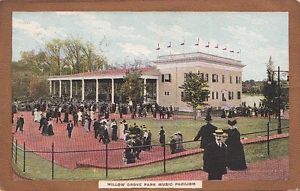
|
| Music Pavilion |
To go back a moment in time, the trolley car was the main method of public transportation in the last half of the 19th Century, blanketing the cities of America and their suburbs, and connecting to the trolley lines of other cities through an interurban network. Somewhere the idea developed of building Amusement Parks out at the far end of suburbs, to attract riders into using the trolleys for more than just commuting; there may have been as many as seventy or eighty such permanent circus grounds in America at one time, with more elaborate attractions that could be managed by traveling circuses. Philadelphia had several such trolley parks, notably Woodside Park in Fairmount Park, serviced by the "Park Trolley". But in 1896 Willow Grove was created on the edge of Abington, far more elaborate than any others, at the intersection of Old York Road and Easton Pike (Rte 611). Its terminal could hold as many as a hundred trolleys at once; the ride from Center City Philadelphia took 70 minutes and cost 15 cents. The area had mineral springs and had long been a favored vacation spot. Horace Trumbauer designed four or five of the buildings, and the Park eventually included a lake with rental boat rides, an arboretum, amusement rides, restaurants, a fun house, silent movie theaters, rodeos, roller coasters, a picnic park, and even an artificial mountain with a slow scenic ride up but a rip-roaring fast descent. By far the most central feature of Willow Grove was the 4000-seat music center, dominated by John Philip Sousa and his band giving four performances a day. Other musical performers were Victor Herbert, Walter Damrosch, Arthur Pryor ("The Whistler and His Dog"). Many of the ideas of Willow Grove are now to be found in the modernized form at Disneyland, but for twenty-five years music under the direction of John Philip Sousa was really the central unifying feature.
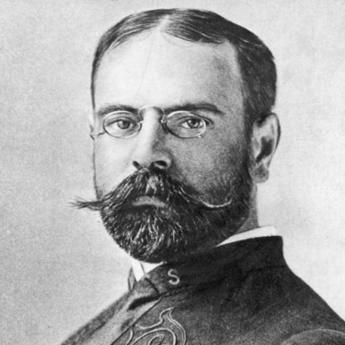
|
| John Philip Sousa |
It's generally held the arrival of radio broadcasting caused the decline of Willow Grove, although "The March King's" immense energy declined toward the end, as he began to enjoy being a multimillionaire. The composition of marches was in fact only a minor part of his musical output, which included among other things 16 full-length Broadway musicals. He was a national champion trap-shooter and a horseman of some note. One arm became nearly useless to him after a fall from his horse. Meyer Davis took over in the last few years, but a major fire pretty well finished the place off just in time to be buffeted by the 1929 crash. There was an attempted resurgence in 1933, but circumstances which made Willow Grove a successful "Virtuoso Solo" just couldn't withstand the competition of the automobile and television, and the land was finally broken up and sold for $3 million in 1976. Remnants of the gilded past are now scattered around the Willow Grove Shopping Mall, for those who wish to renew fond memories from their childhood. Or perhaps their grandparent's childhood.
Wood Turning
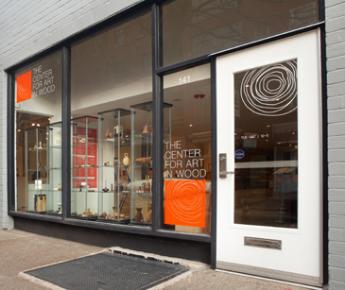
|
| The Wood Turning Center |
A lot of people are named Turner, probably reflecting some degree of ancestry of wood turners. That's an ancient skill, using wood lathes. In Colonial days, commercial wood turning had a focus on banisters of houses, flag poles, and even toothpicks. At the present time, it is mostly a hobby conducted in garages by people who are mechanically inclined; but when a skilled artist takes it up, the products can be exquisite works of art. Because this is America, there is a national club of artisans and admirers, called the Furniture Society, and a local Philadelphia club called the Wood Turning Center. It's located at 141 North 3rd Street. Because of one-way streets, you are advised to consult a map if you plan to drive there, on the north edge of the Ben Franklin Bridge, rather near the Constitution Center. Ron Humbertson, the curator of the museum, recently visited the Right Angle Club and talked about the subject.
The average skilled amateur takes ten or more hours to produce a wooden bowl on a wood lathe, but the professionals manage to do it in about five hours. If you start with a gnarled tree trunk, the product has many interesting lines and whorls. But then the artisan has to contend with knot holes, unexpected holes of wood rot, and the likelihood of cracking the piece in the process of carving it. By far the majority of a piece of raw wood is then carved away and discarded, something that bothers real tree lovers.
Because of all these unexpected features of the wood, the thinner the final piece, the more likely it is to crack and experience other mishaps, perhaps even leading to discards and starting all over. Even just drying the raw wood can lead to cracks, and sometimes even before the carving begins, so real artists gently dry the wood themselves as part of the whole process of producing art. Even if it doesn't crack, the usual finishing process involves five or more layers of clear epoxy finish, to reduce scratching and to hold it together to prevent those cracks. Those bowls which are intended to hold salads had better be crack-free if salad oil is to be poured on the food. Like any other piece of art, the really outstanding pieces are not intended to go on dining tables.
Reservoir on Reservoir Drive

William Penn planned to put his mansion on top of Faire Mount, where the Art Museum now stands. By 1880, long after Penn decided to build Pennsbury Mansion elsewhere, city growth outran the capacity of the new reservoir system which had then been placed on Fairmount. An additional set of storage reservoirs were placed on another hill across East River (Kelly) Drive, behind Robert Morris' showplace mansion now called Lemon Hill (Morris merely called it The Hill); the area was eventually named the East Park Reservoir. In time, trees grew up along the ridge and houses got built; the existence of these reservoirs right in the city was easily forgotten, even though the towers of center city are now plainly visible from them. These particular reservoirs were never used for water purification; that's done in four other locations around town, and the purified water is piped underground to Lemon Hill, for last-minute storage; gravity pushes it through the city pipes as needed.

Now, here's the first surprise. Water use in Philadelphia has markedly declined in the past century. That's because the major water use was by heavy industry, not individual residences, so one outward sign of the switch from a 19th Century industrial economy to a service economy is -- empty old reservoirs. Only one-quarter of the reservoir capacity is in active use, protected by a rubber covering and fed by underground pipes. The rest of the sections of the reservoir are filled by rain and snow, but gradually silting up from the bottom, marshy at the edges. Unplanted trees have grown up in a jungle of second-growth, attracting vast numbers of migratory birds traveling down the Atlantic flyway. Although there are only a hundred acres of water surface here, the dense vegetation closes in around the visitor, giving the impression of limitless wilderness, except for the center city towers peeping through gaps in the forest. It's fenced in and quiet except for the birds. For a few lucky visitors, it's easy to get a feeling for how it must have looked to William Penn, three hundred or more years ago, and Robert Morris, two hundred years ago. In another sense, it demarcates the peak of Philadelphia's industrial age, from 1880 to 1940, because that kind of industrialization uses a lot of water.
The place, in May, is alive with Baltimore Orioles. Or at least their songs fill the air and experienced bird watchers know they are there. Even a beginner can recognize the red-winged blackbirds, flickers, robins, and wrens (they like to nest in lamp posts). The hawks nesting on the windowsills of Logan Circle suddenly makes a lot more sense, because that isn't very far away. In January, flocks of ducks and geese swoop in on the water surface, which by spillways is kept eight feet deep for their favorite food. Just how the fish got there is unclear, perhaps birds of some sort carried them in. The neighborhoods nearby are teeming with little boys who would love to catch those fish, but it's fenced and guarded much more vigorously since 9-11. In fact, you have to sign a formal document in order to be admitted; it says "Witnesseth" in big letters. Lawyers are well known for being timid souls, imagining hobgoblins behind every tree. However, there are some little reminders that evil isn't too far away. Just about once a week, someone shoots a gun into the air in the nearby city. It goes up and then comes down at random, with approximately the same downward velocity when it lands as when it left the muzzle upward. That is, it puts a hole in the rubber canopy over the active reservoir, which then has to be repaired. No doubt, if it hit your head it would leave the same hole. So, sign the document, and bring an umbrella if the odds worry you.

A treasure like this just isn't going to remain as it is, where it is. It's hard to know whether to be most fearful of bootleggers, apartment builders or city councilmen, but somebody is going to do something destructive to our unique treasure, possibly discovering oil shale beneath it for example, unless imaginative civil society takes charge. At present, the great white hope rests with a consortium of Outward Bound and Audubon Pennsylvania, who have an ingenious plan to put up education and administrative center right at the fence, where the city meets the wilderness. That should restrict public entrance to the nature preserve, but allow full views of its interior. Who knows, perhaps urban migration will bring about a rehabilitation of what was once a very elegant residential neighborhood. And push away some of those reckless shooters who now delight in potting at the overhead birds.

This whole topic of waterworks and reservoirs brings up what seems like a Wall Street mystery. Few people seem to grasp the idea, but Philadelphia is the very center of a very large industry of waterworks companies. The tale is told that the yellow fever epidemics around 1800 were the instigation for the first and finest municipal waterworks in the world. There's a very fine exhibit of this remarkable history in the old waterworks beside the Art Museum. But that's a municipal water service; why do we have private equity firms, water conglomerates, hedge funds for water industries, and other concentrations of distinctly private enterprise in the water? One hypothesis offered by a private equity partner was that the success of the municipal water works of Philadelphia stimulated many surrounding suburbs to do the same thing; it was surely better than digging your own well. This concentration of small and fairly inefficient waterworks around the suburban ring of this city might well have created an opportunity for conglomerates to amalgamate them at lower consumer cost. Anyway, it seems to be true that if you want to visit the headquarters of the largest waterworks company in the world, you go about seven miles from city hall and look around a nearby shopping center. If you are looking for the world's acknowledged expert in rivers, you go to the Academy of Natural Sciences of Philadelphia on Logan Square and look around for a lady who is 104 years old. And if you have a light you are trying to hide under a barrel, come to Philadelphia.
Selling Entire Towns
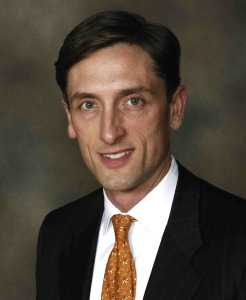
|
| Jason Duckworth |
Recently, Jason Duckworth of Arcadia Land Company entertained the Right Angle Club with a description of his business. Most people who build a house engage an architect and builder, never giving a thought to who might have designed the streets, laid the sewers, strung out the power and telephone lines, arranged the zoning and otherwise designed the town their house is in. But evidently it is a very common practice for a different sort of builder to do that sort of wholesale infrastructure work -- privatizing municipal government, so to speak. A great deal of what such a wholesale builder does involves wrestling with existing local government in one way or another, getting permits and all that. In a sense, the existing power structure is giving away some of its authority and does so very cautiously. Sometimes that involves suing somebody or getting sued by somebody. Perhaps even greater braking-power on unwelcome change is that the wholesale builder is in debt until the last few plots are sold, and realizes his profit on stragglers. Since it often happens that the last few plots are the least desirable ones, this is a risky business. Big risks must be balanced by big profit potential, and one of the risks of this sort of privatization is that too much consideration may be given to the players at the front end, the farmer who sells the land and the builder who must keep costs down, at the expense of the long-range interests of the people who eventually live in the new town. Top-down decision making is much more efficient, but its price is decreased responsiveness to citizen preferences.

|
| For Sale |
As it happens, Arcadia specializes in towns designed to look like those built in the late 19th Century. Close together, a front door near the sidewalks, front porches for summer evenings. To enhance the feeling of being in an older village, Arcadia specifies certain rules for the architecture, to make it seem like Narberth or, well, Haddonfield. Until recently, suburban design emphasized larger plots of land, and few sidewalks, with streets often ending in cul-de-sacs instead of perpendicular cross-streets in the form of squares. The "new urbanism" appealed to those who were seeking greater privacy, revolving around the idea that if you wanted anything you drove your car to get it. Three-car garages were common, groceries came from distant shopping centers. There are still plenty of new towns built like that today, but Arcadia appeals to those who want to be close to their neighbors, want to meet them at the local small stores scattered among the houses. In the 19th Century, this sort of town design was oriented around a factory or market-place; since now there are seldom factories to orient around, the appeal is to two-income families who want to live in an environment of similar-minded contemporaries. The whole community is much more pedestrian-oriented, much less attached to multiple automobiles.
Since Mr. Duckworth mentioned Haddonfield, where I live, I have to comment that the success of living in a town with older houses depends a great deal on the existence of a willing, capable yeomanry. Older houses, constantly at risk of needing emergency maintenance, need available plumbers, roofers, carpenters, and handy-men of all sorts. Because it is hard to tell a good one from a bad one until too late, this yeomanry has to be linked together invisibly in a network of pride in the quality of each other's work and willingness to refer customers within a network that sustains that pride. A tradesman who is a newcomer to the community has to prove himself, first to his customers, and almost more importantly to his fellow tradesmen. If you happen to pick a bad one, good workmen in other trades are apt to seem mysteriously reluctant to deal with you as a customer, because you too are somewhat on trial. Maybe you don't pay your bills, or maybe you are picky and quarrelsome. In this way, the whole community is linked together in a hidden community of trust. Over time, the whole town develops certain recognizable social characteristics that a brand-new town doesn't yet need. If that time arrives without a network of reliable tradesmen, the town soon deteriorates, house prices fall, people move away.
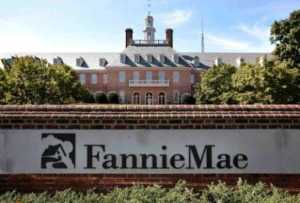
|
| Fannie Mae |
It's curious that the residents of such a town are a breed apart from the merchants in the nearby merchant strip. If the merchants of town life in that same town, there is much less conflict. More commonly, however, the merchants rent their commercial space and commute from distant places. That disenfranchises them from voting on school taxes and local ordinances and creates a merchantile mentality as contrasted with a resident community, dominated by high school students. One group wants lower taxes, the other group wants to get their kids into Harvard. One group wants space for customer parking, the other group is opposed to asphalt lots. And in particular, the residents want to avoid garish storefronts and abandoned strip malls. Since the only group which has an influence on both sides of this friction are the local real estate agents and landlords, their behavior is critical to the image of the town. When real estate interests are not residents of the town it is ominous, and they are well advised to remember that the sellers of houses are the ones who choose a real estate agent for a house turn-over. There's more to this dynamic than just that, but it's a good place to begin your analysis. Suburban real estate interests are constantly tempted to get into local politics, but politicians are the umpires in this game, and it soon becomes bad for their business if real estate agents potentially put their thumb on the scales.

|
| FHA Seal |
All politics is local, but all real estate is not entirely local. The present intrusion of the Federal Government into what is normally a purely local issue has become more pointed in the present real estate recession. Almost all mortgages are packaged and sensitized by "Fannie Mae and Freddy Mac". By overpaying for the mortgages they package, these two federal agencies are subsidizing the banks they buy the mortgages from. Or, that is half of the subsidy. The other half is the Federal Reserve, which presently lends money to banks at essentially zero interest. Acquiring free money from the "Fed", while selling mortgages to Fannie Mae at above-market rates, the federal government supports the banks at both ends. And that's not quite all; there is something called the FHA, Federal Housing Authority, which guarantees mortgages. Essentially an insurance policy, the FHA guarantee is issued for a cost to home buyers who meet standards set by Congress (for which, read Barney Frank and Chris Dodd). Although houses during the boom were selling for 18 times the estimated rental value, they are now selling for 15 times rental. FHA will insure such risks, but the banks won't lend more than the normal proportion, which is 12 times rental. Consequently, almost all mortgages are FHA insured, while the federal administration storms with a fury that the banks "won't lend". And indeed it begins to look as though banks will never issue uninsured mortgages until home prices fall another 25%. If home real estate prices do decline to a normal 12 times rental, a lot of people (i.e. voters) will be unhappy, and not just homeowners who bought at higher prices. The market is fairly screaming that you should sell your house and rent, but so far at least, these federal subsidies seem to be holding prices up. When normal pricing arrives, the recession is just about over, but it certainly won't feel that way if you are a seller.
New Roles For Grandparents
Like everyone else, I had two grandfathers and two grandmothers. However, I can only remember seeing one grandmother on a single occasion when I was three or four years old, and the other three died before I gathered any recollection of them. Essentially, I never knew my grandparents. If they ever knew me, it was as a puking infant, don't he look sweet.

|
| Great Grandpa and Great Grandson |
One of the many unexpected consequences of the introduction of penicillin, polio vaccine and the like, is that my generation has had to invent the role of grandparent, without any models to follow. My grandchildren are all in college or beyond, with reasonable expectations of getting married and starting careers while I watch. I already have two great-grandchildren, and with luck will have lots more. To my knowledge until ten years ago, I never met anyone who had great-grandchildren, so I'm not entirely certain what I'm expected to do with them. I could ask others, but they don't know much, either. Society has evolved a database of experience about how parents are supposed to relate to children, and children have evolved literature about how they are expected to cope with their reflex hostility to their parents. Sigmund Freud made up huge mythology about such conflicts and emotions, and while we are shaking off a good deal of it, Freud did help define the general rules of behavior between parents and children. All of us believe we are exceptions to such rules, of course, but they do make up a road map of the land mines to avoid. Furthermore, most of us formed some firm opinions during the Vietnam conflict or the Summer of Love; presumably, most of our children feel a little silly about it now. Their folk songs record the mythology of that experience; even with guitar accompaniment, these songs all sound a little wry. Sorry about that. Wouldn't have missed it for the world, but sorry about that. Are ya gonna need me, are ya gonna feed me, when I'm sixty-four. Sixty-four? That was twenty years ago.
By this time, the sassy generation has had a chance to learn how sharper than a serpent's tooth it is, as a reminder that there have always been a few who lived King Lear's experiences, but now it could happen to anyone. The two generations, my children's and my own, have now lived a common experience from start to end, not just half of it as Freud depicted. But there's a new twist; the two generations think they have a role with the third generation. Both generations are unclear about what the grandparents' role should be with the new generation of young adults. I know what I think, you know what you think. Neither of us knows anything.
A thousand years of experience teaches how unwise it is to allow any relationship to revolve around gifts and the expectation of gifts. A mere two hundred years of experience make it plain to almost everyone how easy it is to ruin children by making life too easy for them. What does one do, then, with savings large or small, when grandchildren seem to combine aloofness with expectations? Does our society really expect us to favor our personal genome into eons of astronomical time? As one wanders occasionally through graveyards, it is very clear that our nostalgia for great grandparents born in 1814, is small indeed. Should we make an effort to create a lasting impression on such visitors from another planet, or should the whole misty idea of consanguinity be abandoned as a delusion? Should we take the wry advice of those who test our reactions with cynical descriptions? Should we, in a word, attempt to live out our lives with the perfect timing of spending our last dollar during our last hour? Come back in fifty years and there will be shelves of novels, plays, and poetry which tell the sad tales of those who made one choice or the other. Future generations of grandparents will still have to make their own decisions, but at least they will know how the world will view them. One generation will likely cling to the viewpoint of its contemporaries, another generation will reject such viewpoints as nonsense. Our generation will never be quite sure.
Among the funny things about this situation is the curious inversion of the social classes. Everyone notices how domestic servants hang around observing the behavior Upstairs; no matter how firmly it is rejected Below Stairs, employer behavior is marveled at and imitated to some degree. But in the past, those servant social groups who had their children at sixteen, their grandchildren at thirty-two, their great-grandchildren at forty-eight, knew something that those of us who defer our gratifications might wish we knew. The experience is raw and basic, and all the more important for that reason. Some budding novelist, hoping to cloak predictions as folklore, might give that theme a try.
Frank Furness (1):PAFA
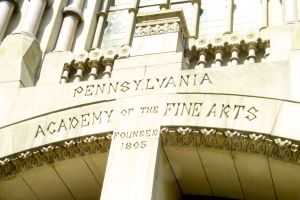
|
| Pennsylvania Academy of the Fine Arts |
The Pennsylvania Academy of Fine Art is notable for its place in Art history, for its faculty over the centuries, and for its influential student graduates. It is therefore not to slight the institution's remarkable place in the world of art if we pause to notice that the building itself, the place that houses all this, is itself an outstanding work of art. Whenever mention is made of Frank Furness, its colorful and influential architect, the first stop on the list is the building he built to house a school and display its glories. Perhaps the best way to illustrate the achievement is to compare it with the Barnes Museum, which also was built to house a school. It also has an outstanding permanent collection, perhaps a greater one than PAFA. But the Barnes building scarcely gets a mention and is about to be abandoned for a preferable location. The Furness building, however, is a massive pile of solid rock, immovable throughout massive changes in its neighborhood. To move that building out to the Parkway has never even been suggested. You can move if you like; we were here first.
The exhibition rooms are interesting, even clever, but the hand and mind of the architect are best seen in the school, the Academy. Seldom seen by the public, the entrance to the school is underneath the front staircase which sweeps the public visitors off to see the exhibition. Up to the stairs, admire the carved walls, the massive supports and the iron railings and out into rooms with scarlet and gold walls, and a blue ceiling with stars. When it leaves, the public sweeps back down the inside stairs and out the tunnel-like entrance, then down the outside stairs. Where was the school?
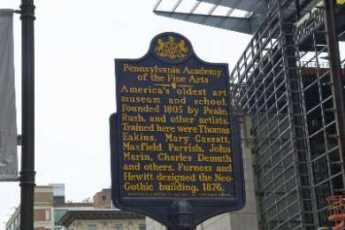
|
| PAFA Marker |
It's underneath the exhibition area, reached by a door under the stairs, unnoticed unless you ask for it. There you will find a darkened lecture hall and corridors lined with plaster casts for teaching purposes. But an artist's studio must have diffused northern light, and lots of it; the problem for the architect was to provide a huge slanted northern skylight over a basement. This trick was accomplished by pushing the walls of the first floor out to the street and installing a slanted skylight in the "ceiling" of the overhang. When the overall effect is that of a fortress meant to defend against a barbarian invader, built with massive walls and roof -- hiding a glass skylight is quite an achievement. Furness was a showman; it was not beyond him to place an architectural tour de force right in front of generations of students looking for something to portray.
We are told the building was five years in construction, designed and re-designed as it rose. The resulting effect is achieved by building around its interior as it evolves from bottom to top. Quite a difference from buildings laid out in advance, forcing the interior contents to conform to the initial design without regard to cramming down its contents. There is an overall design at work here; it's evocative of a Norman church with side extensions, but you have to look for that rather than having the architect thrust it in your face.
Frank Furness (2) Rittenhouse Square
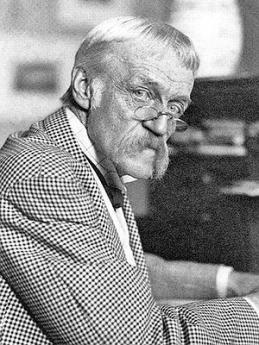
|
| Frank Furness |
George Washington had two hundred slaves, Benjamin Chew had five hundred. It wasn't lack of wealth that restrained the size and opulence of their mansions, particularly the ones in the center of town. The lack of central heating forced even the richest of them to keep the windows small, the fireplaces drafty and numerous, the ceilings low. Small windows in a big room make it a dark cave, even with a lot of candles; a low ceiling in a big room is oppressive. Sweeping staircases are grand, but a lot of heat goes up that opening; sweeping staircases are for Natchez and Atlanta perhaps, but up north around here they aren't terribly practical. Building a stone house near a quarry has always been practical, but if there is insufficient local stone, you need railroads to transport the rocks.
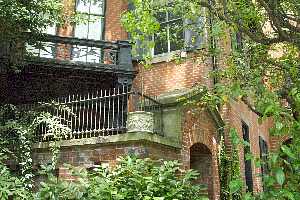
|
| Early Victorian |
So to a certain extent, the advent of central heating, large plates of window glass, and transportation for heavy stone and girders amounted to emancipation from the cramped little houses of the Founding Fathers. Lead paint, now much scorned for its effect on premature babies, emancipated the color schemes of the Victorian house. Many of the war profiteers of the Civil War were indeed tasteless parvenu, but it is a narrow view of the Victorian middle class to assume that the overdone features of Victorian architecture can be mainly attributed to the personalities of the Robber Barons. This is not the first nor the only generation to believe that a big house is better than a small one. The architects were at work here, too. It was their job to learn about new building techniques and materials, and they were richly rewarded for showing the public what was newly possible. Frank Furness was as flamboyant as they come, a winner of the Congressional Medal of Honor for heroism, a man who wore a revolver in Victorian Philadelphia and took pot-shots at stuffed animal heads in his office. He affected the manners of a genius, and his later decline in public esteem was not so much disillusion with him as with the cost of heating (later air-conditioning), cleaning, and maintenance which soon exceeded provable utility. The simultaneous arrival of the 1929 financial crash and inexpensive automobile commuting to the suburbs stranded square miles of these overbuilt structures. It was the custom to build a big house on Locust, Spruce or Pine Streets, with a small servant's house on the back alley. During the Depression of the 1930s, there were many families who sold the big house and moved into the small one. Real estate values declined faster than property taxes and maintenance costs; incomes declined even faster.
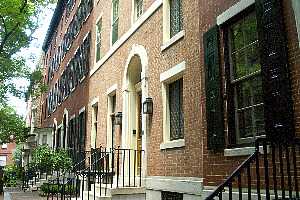
|
| Delancey Street |
It thus comes about that large numbers of very large houses have been sold for very modest prices, and the urban pioneers have gentrified them. You can buy a lot of house for comparatively little if you are willing or able to restore the building. We thus come back to Frank Furness, who was the idolized architect of the Rittenhouse Square area, in addition to the massive banks and museums for which he is perhaps better known. Unfortunately, most of the Furness mansions on the square have been replaced by apartment buildings, but one outstanding example remains. It's sort of dwarfed by the neighboring high-rises, but it was originally the home of a railroad magnate, a few houses west of the Barclay Hotel, and it holds its own, defiantly. Inside, Furness made clever use of floor-to-ceiling mirrors to diffuse interior light and make the corridors seem wider. Although electric lighting made these windowless row houses bearable, modern lighting dispels what must have been originally a dark cave-like interior on several floors, held up by poured concrete floors. Furness liked to put in steel beams, heavy woodwork, and stonework, in the battleship school of architecture. If you were thinking of tearing down one of his buildings, you had to pause and consider the cost of demolition before you went ahead.
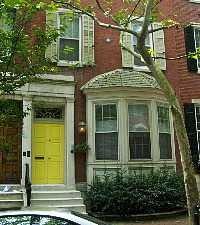
|
| Frank Furness Window |
There are several others of his buildings around the corner on the way to Delancey Street, one of them set back from the street with a garden in front. That's what you expect in the suburbs, but the land is too expensive in center city for very many of them; this is the last one Furness built before rising real estate costs drove even him back to the row-house concept. On Delancey Street, there is a house which he improved upon by adding an 18-inch bay window in front. The uproar it caused among the neighbors is still remembered.
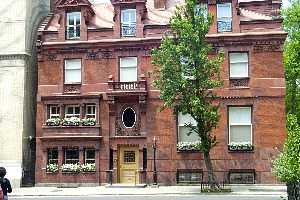
|
| Doctor Home and Office |
A block away on the part of 19th Street facing down the street, Furness built another reddish brownstone house to glare back at the neighbors. The facings of the front suggest three-row houses, and it was indeed the home of a physician who had his offices on one side, entrance in the middle, and living room on the right. The resulting staircase in the middle is used to good effect by opening a balcony on the landing overlooking the parlor below. As befits the Furness style, the wall is thick, the wooden beams heavy. And, in a gesture to the lady of the house, the room adjoining the living parlor is a modern kitchen so the kids can play while mama cooks or guests can wander by as she gets dinner ready. Times have changed, the servants quarters once were plain and undecorated. The lady of the house never set foot in the kitchen so she could care less what it looked like.
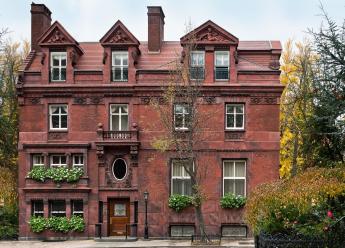
|
| Frank Furness Home |
As a matter of fact, that's the remaining problem for these places, the rate-limiting factor as chemists say. Automatic washers, microwaves, electric sweepers, spray-on cleaning fluids and similar advances are the new industrial revolution which makes these hulking mansions almost practical. What's still lacking is the social structure of Upstairs and Downstairs, the servant community overseen by the lady of the house, who once was sort of the Mayor of a town. The lady of the house is now a partner in a big law firm, or similar. It simply is not wise to leave a big expensive place unattended by someone constantly supervising the domestic help. It is never entirely safe to leave the financial affairs of the household in the hands of someone who is not a central member of the owning family. Perhaps the father of the family can be brow-beaten into spending some quality time with the children once in a while.
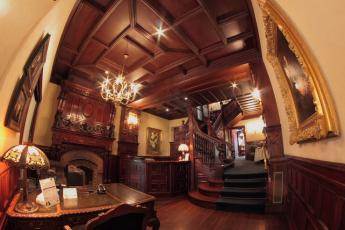
|
| Structure of Upstairs and Downstairs |
Perhaps an accountant can for a fee be trusted with the finances; perhaps a butler can be found who will whack the staff when they get out of line. But the plain fact is these monster houses were built around the assumption that the lady of the house would run them, and the old style of manorial life cannot return unless the house is completely redesigned for it. Someday, perhaps a genius of the Frank Furness sort will make an appearance, change everything, and make everybody want to have it. But it is asking for something else when you insist on this happening in an old stone fortress that was designed to house a different style of life.
Exercise As Fun

|
| Exercise Against Resistance |
Almost every retirement community, cruise ship, and the large hotel have a "fitness center", so there really is no excuse for retired people to be as weak and flabby as they generally are. Arthritis is pretty common, but it is ordinarily so mild that taking a large aspirin or a small Ibuprofen tablet will cause you to forget about arthritis pain long enough to get some exercise. Stretching exercises will often get rid of what pain remains, and you should feel better as a consequence, not worse. All sorts of good things happen when older people start getting regular exercise; but if you are really crippled, the following is not written for you.
A friend who regularly "goes back" to Princeton reunions reports that about half of his class was still alive for the 60th reunion this year. Unfortunately, only eight members of the class were able to walk in the parade. The rest rode in golf carts. Speaking with the understandable bias of a Yale alumnus, I have to say this sort of thing is not necessary at all.
Almost everyone graduates from high school in pretty good condition, and the majority of college graduates are pretty fit at the time of graduation, too. Speaking from the vantage point of the 60th reunion, the fellows who were the athletic campus heroes are generally the ones who have serious hip, knee and shoulder disabilities which become fairly troublesome by the time of their retirement from the workforce. Either that or they soon regale you with stories of their artificial joint replacements. Nevertheless, it is curious that these are the class members who keep up their exercise in some way, usually golf or tennis, sometimes sailing; it almost seems as though it should be mandatory to learn golf or tennis in college, so that by the time retirement comes along, exercise has become a lifetime habit. That even seems to be true of the ones in golf carts because of football injuries in the past, but scientific studies don't seem to have established whether vigorous football, baseball or polo as a youth make you pay too great a price in later life; it would be interesting to know the overall trade-off.
The majority of Americans have a different life pattern and must be urged to change it. After they get married and have a steady job, they abandon exercise pretty completely. A few games on weekends, perhaps, and vigorous summer vacations for a few years in their 30s and 40s. After that, there is essentially no exercise at all, a steady gain of weight ("My, don't you look good,") and if they are lucky, no major illnesses until they retire. The fact is, most people don't much enjoy exercise, and arrive at retirement age with the bravado boast they haven't had much exercise for thirty years. Even the medical profession has abandoned them; doctors tell them that exercise is good for you, a most unwelcome scientific opinion.

|
| Combatting Sarcopenia |
Let's simplify some of the confusion which abounds among trainers and physiotherapists, about the various competing types of exercise. There are three types, and you need all three of them. First, you need to overcome the decades of disuse atrophy which come from endlessly sitting at a desk. The muscles get thin and withered, a condition which luxuriates in the descriptive term "sarcopenia". Start out with about six weeks of the kind of exercise a lot of people say you shouldn't have, the weight-lifting variety, chin-ups, and push-ups, possibly Charlie Atlas-type of pushing one hand up while pushing the other one down, or pushing one foot against another. That's sometimes called "Dynamic Tension". The purpose of all this is to build muscle size or bulk. The professional athletes who look so grotesque with their shirts off tend in addition to resort to self-medication with a mixture of testosterone and growth hormone, but that's not advised for them or for you. It may be that thirty years of administering illicit muscle-building hormones will prove to be statistically harmless, but right now it doesn't seem exactly a wise or harmless thing to do. The professional athletes imagine they can make many millions if they just get a small edge on their competitors, and after that, they can retire in luxury. Even if that dubious claim eventually proves to be true for them, it isn't true for most of the rest of us. If someone is as emaciated as a concentration-camp survivor, perhaps hormones are justified, but it is only wise to undertake it under a doctor's supervision, and only for a few months.
After the muscles have been bulked up for a month or two, perhaps longer if you are incorrigibly lazy, it is time to go to stretching and platform building. Some effort should be made to rotate muscles of the whole body, particularly if there is still an appreciable amount of muscle soreness for a day or two after each session. This is the time for a gym with a dozen different types of machines, each one aimed at a different muscle set. The magic number is five; stretch and pull each muscle group five times and then go to another; usually, it's five times on each side of the body or ten times per machine. Take an aspirin or ibuprofen before each session, and drink at least a glass of liquid afterward. Three times a week is often enough for a beginner to get started; but remember if you give yourself a month's vacation, it will take another month of hard work to get back to 80% of what you had only recently achieved.
After six months or so of this drill, start building endurance. A stationary bicycle, a treadmill, or swimming pool laps are useful for almost anyone. Running on a track is fine, but the majority of retirees have enough arthritis somewhere that they have to be careful about jogging. If the pain appears while doing this, especially chest pain, stop immediately.
A word about shoes. People with ankle injuries, chronic flat feet, or arthritis in the feet and ankles may well find they can't get any endurance exercise because their feet hurt. Before rushing into bunion surgery or some other drastic response, try some foam rubber shoes. These were once special-ordered by a famous seven-foot professional basketball player, who wanted to be three inches closer to the basket when he threw the ball. So, three inches of foam rubber was glued to the sole of his running shoes. Well, you trip if the edges aren't trimmed at the heels and toes, so various other small modifications evolved. Eventually, a commercial version emerged in which the foot is essentially encased in foam rubber, and after walking on them for a couple of weeks, the rubber gets crushed down appropriately. The effect is a molded shoe, just like molded ski boots, with crushed foam rubber instead of fiberglass. Quite often, the effect is to push the bones back into ideal arrangements, with dramatic relief of the chronic pain. If your feet don't hurt, you walk more, maybe even start to jog. During the first few weeks, be careful, or you may stumble and fall on your nose. After a month, you'll forget you have them on, and maybe even forget your feet used to hurt. Progress can be measured by the ability (usually after six weeks or so) to put on regular shoes for a day. Without pain.
Stop Slapping Your Feet!
Most people of Medicare age are offended by the suggestion they don't know how to walk. But just watch a movie of a ballet dancer walking, and then sit on a park bench and listen to your neighbors walking. A great many people walk along, slapping the front of their shoes on the sidewalk with each step. Then, just to verify your observation, watch Scarlett O'Hara glide down a staircase, almost floating on air as she goes. That girl knows how to walk, and most people don't.

|
| Duck Walk |
A great many people complain to the doctor that their feet or ankles hurt when they walk downstairs, but not when they walk upstairs; how could that be? It's pretty simple, just watch them do it. When they walk downstairs, usually hanging on to the banister as they go, they sort of "fall" on the good foot. That is, they slap the stair as they go, letting gravity drop that foot to the stair instead of lowering it the way they lower the "bad" foot. Essentially, they are falling down the stairs with a jolt to the good foot on each step, just as the sidewalk slappers are falling to the sidewalk with each step instead of walking with their muscles the way a cat would do. When there is a serious pain in the bad foot, they reverse the process, going down "one step at a time". But they know they are doing it, and the pain keeps them from doing otherwise. By contrast, notice how Vivian Leigh would do, when she glides across the ballroom into the waiting arms of Clark Gable. Or the ballerinas in Swan Lake floating around in circles, dipping their arms to the right and left. Those people are not throwing their feet forward and slapping down on them, they are using their muscles continuously, one foot touching the floor slightly before the other foot leaves it. Try it yourself; until you get used to it, at first it's pretty hard work.
But it's a lot easier on the joints than the slap-slap, once you do get used to it. One of the reasons why that so lies in the better posture it requires, with the head balancing on the column of bones in the "core" of the body, rather than extended forward where it has to be held steady by determined muscle action. Furthermore, it requires stretching of the opposing muscles, relaxing the hamstrings for example, and letting the pelvis assume a better angle. When stretching and muscle training get the movements to be better coordinated, the mysterious aches in the back and neck -- just go away.
So, in addition to the various big rusting gadgets strewn around the room, a good fitness center needs several floor-to-ceiling mirrors for self-observation. Once you learn the signs of bad body mechanics and can see it in yourself, much of the corrective posture takes care of itself. Walk like a cat. Not like a duck.
There She Goes, Miss America
Atlantic City has long been a summer resort, crowded with people on the boardwalk by the sea. But families suddenly disappear at Labor Day, when the kids go back to school. So, in 1921 the merchant community hit on an idea to extend the busy season an extra week, by having a big beauty contest on the week following Labor Day. The early Miss America contest struggled for a year or two and then became an established annual national ritual. The hotels and boardwalk did indeed stay crowded for an extra week, during which a publicity campaign was conducted to build up anticipation for the big Saturday night event. The preliminaries included interviews and mini contests, for the bathing suit division, the evening gown division, arguments about official state representation, occasional scandalous behavior, parades in open convertible cars, and whatnot and whatnot. Behind the scenes, there were little local battles, including a grim determination not to have a negro girl represent a state from the old Confederacy. Since only one Jewish girl ever won the contest in eighty years, there were probably other issues in other states, hidden behind the curtains. Smoking and drinking were prohibited but scarcely non-existent, as was getting married or pregnant; much of the fuss about these lesser moral issues was probably intended to cloak the event with the high moral tone, counteracting some unfortunate early beginnings of the pageant, and the exciting laxity traditionally associated with summer resorts by the ocean. But they aimed at and succeeded in attracting, a certain kind of audience.
For months before the pageant by the sea, preliminary contests were held throughout various states to select the local Queen, Miss Arizona, Miss Mississippi, Miss Delaware and so on. The people involved in these local contests duly trooped to Atlantic City to see the big event and cheer their candidate. Over time, it became clear that some states worked really hard on this effort; Mississippi was a notorious big spender, and a consistent big winner, but others were almost as determined to win. The grassroots campaign was largely centered on small-town high schools, but the effort was conducted by a great many local women, mostly middle-aged and often quite homely, who somehow got control of local beauty politics and ran the local contests. Over the years, two of these groupies had been nurses who worked in hospitals where I was a consultant, and I got to watch their enthusiasm bubbling under the surface. One woman had worked for years as a night nurse. The sort of person who sleeps all day and works all night tends to be a little odd, often slightly hostile. But when I asked this ancient battle-ax every year about the contest, she immediately blossomed and went on for half an hour about the gossip surrounding this year's contestants and winner. There was something about all this which was like the fantasies of playing with dolls, fulfilling unfulfilled dreams. If you pause to think about it, that enormous convention hall in Atlantic City wasn't filled with school kids after Labor Day; the school kids were back at school. Although the publicity was all about kids and giggles, the real fans were dreaming of days long past, perhaps as former beauties, more often only wannabes, their dreaming only intensified by knowing for a certainty that this success would never be theirs.
It was this self-delusion quality which the promoters of the contest never seemed to get through their heads; after all, the pageant was created and promoted by local merchants who mostly aimed to sell salt-water taffy to the rubes. Radio, and then television, gave the Miss America contest a big publicity push, and then eventually used up its material. When the casino crowd moved into A.C., the non-gambling ladies playing with dolls quickly demonstrated they didn't gamble, in fact, would sass the serious gamblers for their idiotic behavior losing money as fast as they could. TV ratings, contest attendance, and publicity began to fall off rather seriously. The idea was tried that perhaps women now wanted careers, so "points" were awarded for talent shows, musical performances, and brief contests about current events. Foo. That's not what the audiences wanted. So the contest moved to Las Vegas, and the date was shifted to January, a slow time for casinos. The awards were shifted from national tours and opportunities for screen tests to the awarding of college scholarships. Unfortunately, most of the contestants were already in college or married, and the scholarships were in fact mostly used to pay off trailing debts from colleges already attended.
So Miss America, now regularly a black woman but seldom a Jewish one, continue to be fodder for the sponsors and promoters of the pageant. But wherever it goes and whatever its modifications, the Miss America contest is never going to return to former glory until it learns who its real audience is. The lonesome, middle aged lady who dreams of playing dolls with live dolls.
And then, Miss America went away. Some other city has her. Atlantic City lost her. And there she goes, Miss America.
Disappearing Stock Power
The Right Angle Club of Philadelphia recently heard two presentations on newer investment strategies, one by our member on hedge funds and private equity, and a week later by his guest from Black Rock, on ETF funds. For the purpose of this review, both presentations ultimately got around to the same issue.
In the case of private equity, the investor purchases a share of aggregated profits from a company in the business of buying a substantial or controlling interest in corporations, usually underpriced or underperforming ones. And then, the private equity fund attempts either to fix up the company and sell it or fix it up and hold it indefinitely. Whether or not he achieves a profit, the individual investor in the fund loses the opportunity to vote the shares, or has it offered in such an awkward way the opportunity is meaningless.

|
| Hedge Fund |
A hedge fund similarly buys and sells stock on its own account, employing the money of investors, and generally adding huge amounts of borrowed debt. In this case, the stock is often held for such short times that voting rights are lost in the registration requirements. Taken as a whole, however, the issue is substantial, since it is reported that 70% of recent transactions have been conducted by unattended computers operating by pre-arranged contingency instructions, often responding in fractions of a second. While the resulting immobilization of voting rights is substantial, the main problem with hedge funds has been the way very small profits have been magnified by staggering amounts of borrowing, potentially causing very large losses if the transaction system is slowed for whatever reason. While hedge funds did perform well during the 2007-2009 crash, it will be 2012 before the incredible volume of transactions can be analyzed to see how close we were to disaster. There is definitely a risk in doing nothing, but probably less than the risk of ill-informed legislation making matters worse in some way.
In the case of ETF, the operator or "manufacturer" of the fund attempts to buy blocks of stock in all or representative samples of the companies listed on some index, weighted in proportion to their weight in the index. The intent is never to sell that stock, merely evaluating the fund price and its dividends as a mathematical exercise, and repurchasing or reselling the calculated bundle to other investors, but never disturbing the contents of the bundle unless the index changes its composition.
In all third-party investing cases except hedge funds, the advantage is that reduced tax and transaction activity saves costs, and avoiding internal selling of stock means essentially no taxes are payable until the investor ultimately sells the fund. The managers of funds maintain that these tax and overhead savings completely compensate for losing whatever opportunities for profit would come along and be exploited by expensive "active" managing of the funds. (Some investment funds employ more Ph.D.'s than any American University does.) Even if the performance turns out to be somewhat lower, there is a safety factor of exactly matching the averages, and thus agreeing to surrender the opportunity to join half of the universe of investors in beating the average, in order to avoid joining the other half of investors in doing worse. Furthermore, distributing the investment over a large group of corporations confers diversification, and thus surrendering the chance of a windfall profit in return for avoiding the occasional disastrous loss. In a sense, the fund investor no longer hopes for a company to do well, he hopes for the whole nation to do well. Summarizing the details, these funds provide safety of diversification and reduction of turnover costs, in return for assured but marginal above-average performance. Since this outcome is so greatly superior to the actual experience of non-professional investors overall, it is highly attractive to many investors and should be attractive to more of them.
In addition to these common features, the hedge funds and private equity expose the investor to the risks and rewards of choosing a skillful manager, who may or may not choose the portfolio wisely, and who may or may not use leverage wisely. The choice of portfolio companies, on average, justify a greater degree of borrowing as their quality improves, and all investment borrowing involves a risk that interest rates may go up for reasons unrelated to the investment. In the recent debacle, hedge funds did comparatively well, but nevertheless, there are times when it is unwise to borrow against even the safest securities. And finally, because of the risk of stock market raids by outsiders, hedge funds are quite secretive about their portfolio contents and force the investor to "lock in" his illiquid investment for several years at a time.
There remains one characteristic of both funds, and for that matter mutual funds, annuities, life insurance and all other forms of aggregated investing through a third party. The third party retains the right to vote the shares, admittedly with some little-used and generally unworkable opportunities for investors to request their own proxies. Such third parties almost always vote the shares in their custody in favor of management. There are occasional exceptions, as when union-managed funds will vote their shares in a political manner, or as when some mutual funds attempt to obtain pension fund business in return for cooperation on selected proxies, or in one legendary story the custodian was instructed: "Always vote AGAINST any management proposal." But these are presently exceptional situations. In the vast majority of cases, the proxy votes effectively disappear, and control of the companies in the portfolio gradually gravitates into the hands of those few stockholders who retain direct ownership and take the trouble to vote it. In fact, it is increasingly the case that the most effective way to frustrate a management proposal is not to vote against it, but to abstain entirely, in the hope that a quorum cannot be assembled.
Another popular movement augments this unfortunate situation. Increasingly, it is urged that top management be paid substantial parts of its reimbursement by stock in the company or options on it. The argument is that it is important to align the motives of top management with the rest of the stockholders. Reflecting concern about some recent events, such stock is or should be forced to bear the covenant that it may not be voted in a stock take-over by an outside raider, to frustrate the commonly used inducement to the manager to sell out his stockholders in a merger. Even when this particular contingency has been foreseen and prevented, the effect of increasing the shares in the hand of management and decreasing the voting shares in the hand of the outside public by freezing them in third-party funds -- soon puts the idea in the heads of managers that they own the company. The recent public indignation about inordinately high salaries for top management, can in large part be traced to the plain fact that voting control of the companies is visibly shifting into the hands of the people who receive those salaries.
Killer Instinct
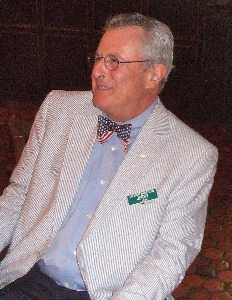
|
| Jerry Leon |
Once every year or two, a speaker at the Right Angle Club fails to show up. That happened recently, and as usually happens, one of the members stood right up to the microphone and gave an impromptu speech. The volunteer was Jerry Leon, who surprised us all by announcing he spent thirteen years in the Marines as a fighter pilot on aircraft carriers. You would never guess that from his behavior as a successful businessman, and to some extent that was his whole point.
In the first place, he volunteered as a Marine during the Korean War, and worked his way through boot camp and all that, until one day an officer brought them all to attention, asking for volunteers to fly airplanes. After flight training school, he might have flown air freight or eight-engine bombers, but he volunteered to fly fighter planes off the deck of an aircraft carrier. In those days, the carrier plane was fired by a steam driven catapult off the flight deck like a projectile. You go from zero speed to two hundred miles an hour in two or three seconds; the experience is arresting. After he recovers his wits, the pilot is expected to take sole control of the plane, fly around the carrier a few times, and then land the plane on the postage stamp flight deck. Fighter planes come in at a lower altitude than commercial aircraft, and steeper, and faster. The tailhook catches one of the three wires across the deck, and then the plane jolts to a stop. Or not, in which case the pilot must retake immediate control, take off at full speed, circle the carrier, and try it again. That's hard enough on a calm sea, but the Navy never stops for rough weather, so at night in rough seas, you have to do it in the dark with the ship rising, falling, pitching and yawing, right or left in three dimensions. That's somewhat harder. There are usually four planes in the air at any one time, all doing the same thing every ninety seconds, and if the plane runs off the end of the landing strip the pilot must remember to eject before he goes down with the plane. This whole process must be repeated six times in one day with only one aborted landing, in order to qualify for carrier duty. Saying nothing of the sudden bumps and jolts, the process of qualifying is pretty hard on the sphincters, it's pure terror no matter who you are. Like stage fright for an actor, crash landing does seem easier with practice but having done it seven hundred times, Jerry still wasn't able to do it calmly.

|
| P40 War Hawk |
Unusually good eye/hand coordination is something you are born with, and baseball seems to require the same ability. Ted Williams, the famous .400 hitter for the Boston Red Sox, was an outstanding fighter pilot, and many less famous professional baseball players have also gravitated to the role. To be called a fighter ace a pilot must have shot down five enemy planes, and one pilot became a fighter ace at the Battle of Midway on his first mission. Because of his lack of experience, this pilot was only detailed to hunt for the battleship Yamamoto, but he found it, radioed its location, and on the return flight ran into 30 enemy planes. Tearing into them alone, he shot down five, becoming an ace before he returned to the carrier deck from his first mission. Now there's the killer instinct with eye/hand coordination, the combination which seems to make you an ace. He wasn't alone in these qualities, although 30% of the pilots do seem to account for 90% of the victories. In those days "between W-2 and Korea" the American pilots were flying propeller planes, while the Chinese pilots were flying jets, and even the Germans were flying some jet-powered Messerschmidts. That's five hundred miles an hour versus seven hundred, and the enemy planes would often swoop past in a whoosh. So, the Americans developed a technique. When the jet came up on your tail, you pulled back as hard as you could with all flaps down. The enemy jet pilot had to pull up his nose, flew over the top of the propeller-driven American, and then was blasted out of the air by the prop plane now waiting for him from behind. They say it worked every time, but of course, it only worked for the pilots who came back to talk about it. A former pilot with Chenault once told the story of letting go with fifty-caliber machine guns into the tail of a Zero, causing the Zero and its pilot to vanish into a puff of smoke and debris. Of course, the prop plane then just flew through the cloud.
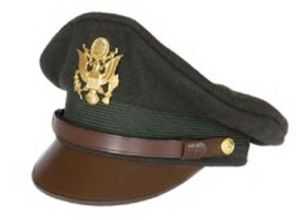
|
| Pilot's Hat |
The fly-boys were of course chased by hordes of women, particularly in the bars around the training school in Pensacola. They drank hard, at reckless heedless parties; it was reported that Australian pilots even had two or three drinks before taking off, but our Navy strictly policed going that far. Nobody saved any money, nobody cared one whit about being promoted or demoted. Getting to be an Admiral was something that attracted what were disdainfully referred to as "politicians". And nobody bragged about his exploits, even to friends and family. What mattered was that word of mouth had carried your exploits to your buddies. The senior George Bush flew a bomber not a fighter plane, but he played baseball like an angel, and you never heard him boast of his adventures; that's a fair approximation of the personality type, although George Bush was unusually tall for a pilot, and clearly better bred. If you can't guess what he thought of Bill Clinton and Ross Perot, it isn't necessary to relate it here.
Somehow, feminist women intruded themselves into this fraternity, and some who seemed well-qualified got hustled along through token promotions. But few women have the real killer instinct, and just getting equal opportunity won't get you through those six gut-wrenching flights in a carrier qualification. Thirteen women pilots were killed in qualification flights before the Secretary of the Navy intervened and put a stop to it. To new entrants from a previously shunned group, achieving the same status as men is a form of promotion, and lusting for promotion is despised by natural-born fighter pilots. It's sort of a Catch-22 situation. What killers want, is to excel at things that are viciously dangerous, getting the esteem of others who tried to do as much and maybe failed; like tournament golf, in this game, you are really playing against yourself. And so this Greek tragedy finally came to a confused pause with the famous Tailgate party incident. To preserve appearances and rescue The Service from the press corps, the Navy brass was shocked, shocked, to discover what was going on. Women weren't being respected if you can believe such a thing of fly-boys.
"Hey, fellas, c'mon. Do you want to win this war or don't you? Professional killers have been behaving like this for centuries. And because you come along, we've got to change and do things your way?"
Insomnia

|
| Philip Gehrman PhD |
Philip Gehrman Ph.D. a research psychologist at the University of Pennsylvania recently entertained the Right Angle Club with a talk about his specialty of insomnia. While most people have occasional episodes of insomnia associated with stressful episodes, drugs or painful discomfort, only about 6-10% of the population complains of chronic insomnia. By which they must mean unwelcome insomnia because a certain population subset simply requires less sleep than average and are able to get more work done because of it. From this, we must infer that insomniacs are uncomfortable with their inability to get to sleep when they want to. Some scientific studies suggest that the condition is associated with restlessness, rapid pulse, sweating and other signs of excessive adrenaline secretion. Without that, you don't have insomnia, you just don't sleep much. The waking state is normally associated with an increased number of beta waves on the electroencephalogram, and insomniacs also seem to have this beta wave pattern when they are asleep. About 30% of insomnia patients seem to carry a family disposition to it.
It does seem to be true that feeling chilly makes you feel sleepy, so there is a seasonal variation. That observation, which has some therapeutic value, is confounded by the fact that melatonin secretion by the pineal gland is related to the daily cycle of daylight, which is of course seasonal. Melatonin, by the way, has some value as therapy for insomnia as well as jet lag, but unfortunately, the melatonin pills available over-the-counter in drug stores have proven in the past to have wildly variable content of melatonin.

|
| Insomnia |
On a personal note, your scribe decided to throw away his alarm clock when he retired; I was at last able to sleep when I darn pleased. It became noticeable that over time, my spontaneous wake-time in the morning had a somewhat seasonal pattern, earlier in the summer, later in the winter. If you set an alarm clock, you are truncating your innate sleep pattern, which in turn readjusts your spontaneous bedtime. If you simply must watch the 11 PM news, of course you sometimes overextend your wakefulness, unless it is winter and a different perturbation occurs. Somehow, this isn't insomnia, because it doesn't bother people much. In fact, a state of chronic but voluntary sleep deprivation is often perceived as the mark of a go-getter, someone destined to succeed. It might prove of interest to do comparative studies with people living in Iceland where the variations of daylight go to greater extremes, compared with residents at the Equator where the sun rises at 6 AM and sets at 6 PM, every single day of the year. Come to think of it, the custom of siesta has grown up almost exclusively in regions near the Equator, while in northern Norway it is not uncommon to make appointments to meet friends at 3 AM.

|
| Coffee |
Alcohol and caffeine have some paradoxical effects, which it is well to keep in mind. Alcohol, as Shakspere had Macbeth's gatekeeper remark, makes the drinker sleepy at the party, but tends to wake him up early, in a sweat. The effect is for the chronic alcoholic to boast that his drinking never causes him to miss going to work, hung over though he may be. Caffeine is just the opposite; it peps and wakes you up after you have a cup of coffee, but in other circumstances, it puts you to sleep. That's because a heavy caffeine consumption leads to a mild addiction, so intense that some people are kept awake by their cravings. The common tip-off of addiction to caffeine is the statement that "I can't get to sleep without a cup of coffee". In recent years, the addiction to caffeine-containing drinks augments the custom for teenagers to escape the world's complexity by staying up most of the night playing computer games. All in all, these features of excessive caffeine are things parents ought to discourage, although the teenager's attempt to escape authority is most of the explanation behind the otherwise inexplicable resistance to a sensible suggestion.

|
| Sleep Apnea |
When you snore, you are usually lying on your back, so you can choke on your tongue enough to wake up. Obesity leads to a pot belly, which increases the tendency to sleep on your back. So this combination of obesity and daytime drowsiness can lead to the discovery of an unrecognized case of "sleep apnea". Since snoring and choking episodes tend to wake up a bed partner, the third feature of this clinical syndrome is sleeping alone. Therefore, a bed partner who diplomatically finds an excuse to sleep in another room may actually be protracting the problem by avoiding its confrontation.
A word of warning about sleep apnea. It's pretty common, and the choking episodes are often not recognized by a bed partner, even a medically trained one. The idea of possible sleep apnea should be seriously considered in anyone with chronic daytime drowsiness.
One final simple piece of advice. Since nowadays just about everyone is being advised to take an aspirin tablet daily to prevent heart attacks, why not get in the habit of taking it at bedtime. If some minor discomfort is keeping you awake, this change of routine might be sufficient treatment for the issue.
America's New Theater Capital
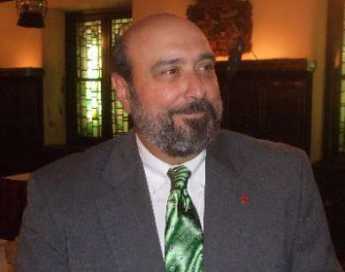
|
| Gene Terruso |
In the Elizabethan era, London experienced a remarkable burst of legitimate theater; Shakespeare was only one part of it. There were fifty-five theaters in London at a time when only two were open in Paris; no one is certain why that happened. Similarly, no one is sure why Philadelphia has decided to have a flourishing theater scene, but if you look around it is true. After 1929, Philadelphia became a "try-out town" for plays hoping to go to New York; we were in a class with New Haven CN and Washington DC. Home-grown talent languishes in competition for audiences who would rather see famous visiting stars. The try-out image is harmful and must disappear before local talent can develop. Once established, however, audiences rather like a theater company with a deep bench; fresh young aspirants at every level, as contrasted with one famous star surrounded by hacks in the lesser roles. The same reaction is seen in minor-league baseball. And no doubt union seniority systems are partly designed to protect the hacks from competing young aspirants. A certain amount of amateurism is forgiven for inexpensive amateurs; when they get expensive it's better to watch movies. The Right Angle Club was pleased to have it all described if not explained by Gene Terruso, the Professor of Drama at the University of the Arts on Broad Street where the old Ritz-Carlton used to be.
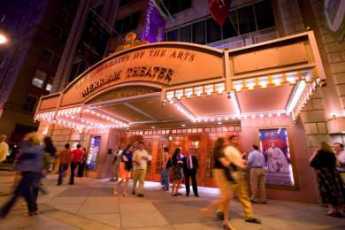
|
| The Merriam Theater |
As far as inside gossip is concerned, the Merriam Theater is owned by the University of the Arts but is sort of doomed to shabby prosperity for the next 13 years by a lease which is too lucrative to modify. That's why the seats are a little uncomfortable, the lobby dilapidated, and comparatively few student productions are on the stage. The University would like to have more student presentations but isn't in a financial position to displace the tenants generating such high revenue. The best that can be made of the present arrangement is to encourage the visiting professionals to mingle with the drama students, bedazzling and advising them how to advance in the Big Time. It's been a fairly successful compromise.
Until recently, Chicago seemed to have the most successful regional theater experience, but now is thought to be on a par with Los Angeles, Seattle, and Cincinnati whereas Philadelphia has supplanted it as the very best place to be. Going backstage, the kids express little interest in going to Broadway, where overpriced theater seems to them to be just part of the tourist industry. Television is regarded as old-fashioned, so Hollywood is unattractive to them, too. If that's all the future holds, these kids would rather become accountants and computer engineers. And stay right here if they can; that seems to be a central motif. Gene Terruso says there is an "Iceland phenomenon" in Philadelphia, a wonderful hidden place to live, so tell everybody else it is cold and dreary and they will stay away and not ruin it.
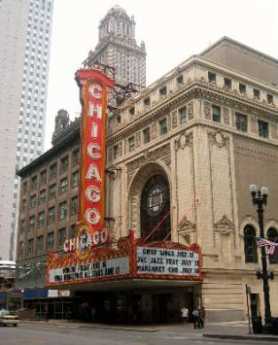
|
| The Chicago Theater |
The fact seems to be that Chicago is seen to have a great many "hole-in-the-wall" theaters, while Philadelphia has well over thirty flourishing theater troupes. The professor in him prompts Gene Terruso to postulate that the secret of our success is for each repertory troupe to specialize in something, get good at it, and bank on the motto Be clear about your mission; the audiences will follow. Therefore, we have Shakespeare companies, musicals companies, Restoration comedy companies, and so on. Some specialties are obviously more popular than others. Somewhere in this business school analysis is the likelihood that artsy craftsy people are seldom very good at running a business, so theater success does depend on non-actors who are business-oriented minding the store, and possibly not much good at acting. It's a lesson many idealists and liberals need to learn, and not just in the theater.
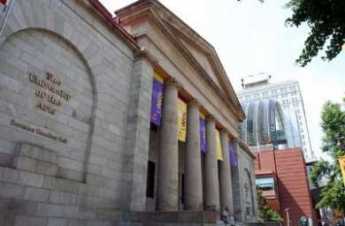
|
| University of the Arts |
Professor Terruso does ruefully admit that the University of the Arts is a conservatory, by which he means a trade school. Its graduates are more likely to know how Hamlet should run a sword through Polonius without killing the other actor than to discuss the place of Shakespeare in our cultural heritage. To have a successful theater, however, there has to be an enthusiastic audience. Somewhere, our universities have found it easier to provide a liberal education to one group of people and impart the tricks of the trade as a specialty of someone else. If the two talents merge at all, it is in the profession of Dramaturge, but all in all, it would be better if both sides of the footlights understood each other somewhat better. Going to the theater really isn't a specialty, and it isn't a secret society, either. That's part of the response to city leaders who greatly desire a thriving theater, but wish we didn't have to see so many of those artist types walking around town. Both groups need to understand "There's plenty of room at the top, but no room at all at the bottom."
Ms. Mayor
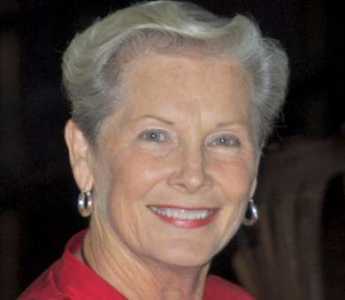
|
| Mayor Letitia Colombi |
One of the great treasures of Haddonfield is a letter from Benjamin Franklin to the husband of Elizabeth Haddon, to the effect that she was the most forceful woman of the region. Indeed, it is part of the tradition of the Haddonfield Meeting of Friends that the men's meeting and the women's meeting met is separate rooms and kept separate minutes at that time. Elizabeth was the clerk of the women's meeting, and while the men's meeting would sign the minutes as "The Meeting on Stoy's Landing" or the "Meeting near Cooper's Creek" or something else topical, the minutes of the women's meeting were consistently signed in a single way. They were from the meeting in Haddonfield. Ultimately, everybody gave up and named the town Haddonfield.
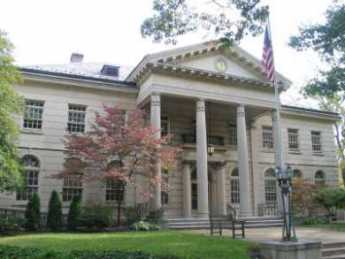
|
| Haddonfield Borough Hall |
Without being able to recall a single other woman who was Mayor of the town, it does seem appropriate that its present mayor is a lady and a forceful one at that. Letitia Colombia has been on the Borough Board of Commissioners for nearly twenty years and seems likely to remain Mayor for as long as she wishes. In the tradition of forcefulness, a number of old timers in the town remember when she first got elected by knocking on every door in the town, and then marched down the main street in the July 4th parade, wearing high-heeled red shoes.
The Right Angle Club was curious to see what this was all about, and her performance was a brilliant demonstration why politics is a full-time sport of every town in Texas. Odessa, her home town, is a few miles from Midland-where-the-oil-comes from, and she and Laura Bush probably attended the same high school. They are certainly both members of the same school.
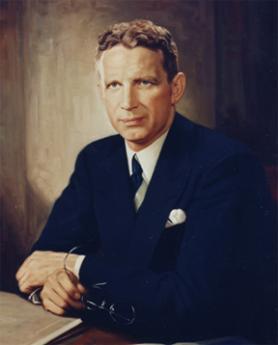
|
| Al Driscoll |
In many ways it was Al Driscoll who as Mayor asked why Haddonfield couldn't be like Princeton, where he once went to school. The answer he got was to change the zoning ordinances and then just wait thirty years. It worked fairly well, although Haddonfield got a parking and traffic problem along with the good features of looking like Princeton. But it wasn't Tish's way; one might say it wasn't the Texas way. She hired some consultants at a cost of $125,000 to work out a detailed plan for changing Haddonfield for the better, and then followed the plan. It included a list of the kind of stores you do and don't want in a town of this type and the general strategy of attracting them. The zoning laws are sort of like Princeton's, but different enough to matter. Year by year, you can see the town change from a sleepy little place into a lively place to be. There are no empty lots in Haddonfield; to change the town, you have to remodel everything, house by house. On a summer evening, there are throngs of people on the sidewalks downtown, entertained by three or four street bands, wandering up and down at the sidewalk sales of the merchants. Haddonfield is "dry" in the sense that liquor sales are prohibited; that policy was recently reconfirmed by a four-to-one vote. But it hasn't kept restaurants away. The residents like BYOB a lot, and fully understand what it means.
Taxes in Haddonfield are, well, generous. But Haddonfield gets no state school aid; its schools are much like a thirty-million-dollar private school system, run by locals to local taste. And a quarter of our taxes go to Camden County. Tish boldly announces we get nothing whatever for those taxes in return. With a slogan like that, it's pretty hard to doubt she's a Republican.
REFERENCES
| Heroines of Haddonfield 1713-2013: Christie Castorino: ISBN: 978-1-4836-2719-9 | Xliris |
Rationing, No Matter What You Call It.
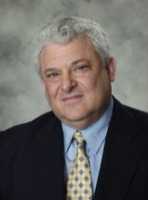
|
| Arthur L. Caplan |
The Right Angle Club of Philadelphia was recently addressed by Arthur L. Caplan, Director of the Center for Bioethics of the University of Pennsylvania. His topic was Healthcare Rationing. It was interesting to hear the viewpoint of someone who views the 2010 mandatory health insurance system primarily through the lens of its ethics; just like the Tea Party objectors on the other extreme of politics, he sees the new law as merely a rationing system. However, his initial salvo is similar to that of the bill's proponents before it was enacted: "Every system always rations in some way or another." If you expected the outcome to be rationing from the beginning, your focus is naturally fixed on just what sort of rationing you get, perhaps measured by whatever kind of rationing you had formerly hoped for.
Ethics is, after all, a system of constraining native, unconstrained, outcomes into something deemed more suitable. That's a definition which could be equally well applied to the reform of all sorts and repeatedly tends to cast reformers as underdogs fighting the establishment. Since the American healthcare system in 1950 could fairly be described as rationing healthcare with money, and its history from then to now has been one of jumbled similarity to 1950, most discussion accepts a financial rationing description for what Obamacare changed. There is much uneasiness about totally supplanting the marketplace with insurance since universal insurance leaves no room for setting prices -- except by government proclamation, filtered through some sort of insurance bureaucracy. There was a time when many people thought that was better than paying for it yourself, but now that it's here, there are growing doubts.
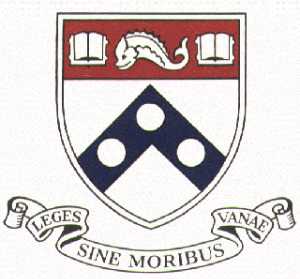
|
| UPENN |
There's surely going to be a last-ditch effort to overturn Obamacare, whether through Congress or the Courts and failing that, through stalling it until the President can be replaced in 2016. Let's assume for the moment that such efforts fail, and are not followed by armed rebellion. If the central issue is how do we find more acceptable methods of rationing, two proposed methods have begun to seem attractive. The first is proposed by Congressman Ryan of Wisconsin, to the general effect of taking what we now spend, chopping it up, and issuing vouchers for the same amount less net middle-man costs. This approach stops the rise of costs right where they are, and thus pleases Congress. But the thing to be rationed is redefined as well. It rations future cost rises, net of any savings wrung out of the system by competition for voucher money. It's fair to claim this system should not deny the present level of care to almost anyone. It has a price, however. If you want future miracles, you have to pay for them.
A second proposal depends on the observation that most healthcare costs are concentrated in the first year of life, and the last year of life. Strip those costs out, and what is left would almost surely be manageable, particularly in view of how the concentration of costs in those two areas steadily increases. Essentially, this system promises to take generous care of the helpless when they are born and when they die. Healthcare costs during the years of school and employment, however, could more confidently be left to people who are sentient and reasonably healthy, so that's where the inevitable rationing would be concentrated. Once more, the payment system has been modified to avoid such third-rail issues as euthanasia for Grandma or for self-inflicted diseases, or even for abortion. Those would be left to the public to manage during stages of life where there is a reasonable likelihood that the patient's own wishes can be paramount. For now, we pass over the technicalities of last-year-of-life insurance, but it could fairly begin with reliance on reimbursing Medicare after the fact, while traditional first-dollar insurance for pregnancy and newborns, or even mandatory government reimbursement, might seem acceptable even to strong conservatives.
So, what's proposed here is a substitute for both the traditional system and the bewildering command and control system of Obamacare. It shifts the subject matter for rationing away from those areas that frighten the public the most, toward either: rationing future unknown scientific advances, or, rationing healthcare during the years when it is comparatively predictable and involves patient cooperation during the years of reason. That's the summary; other proposals are welcome.
Regrettably, after each November election, we first must potentially endure a lame-duck Congress, followed by two years of White House-Congress gridlock. There will, unfortunately, be scant tolerance for ethicists, during those grievous national experiences.
Obituaries, 2010
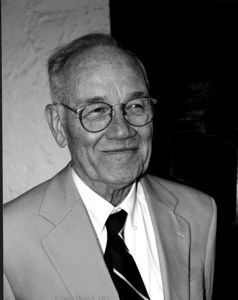
|
| James Edwin Wood |
James Edwin Wood. 1924-2010.
Ed Wood had been Chairman of the Department of Medicine of The Pennsylvania Hospital for 21 years. A distinguished research cardiologist, he was born in Charlottesville, Virginia, graduated from Davidson College and then from Harvard Medical School after a two-year stint in the Navy. His most distinguished research was least known because of its wartime secrecy, involving ten flights during atomic explosions. The Medical Clinic of the Pennsylvania Hospital was re-named in his honor the J. Edwin Wood Clinic.
Ed ran the Boston Marathon five times, the last at the age of 63. Members of the Right Angle Club will long remember his soft Virginia accent, and the long string of somewhat off-color stories he told with it.

|
| Peter Shaw Hanson, Sr. |
Peter Shaw Hanson, Sr. 1925-2010.
Pete was born in Cleveland OH and graduated from Western Reserve Academy and the University of Virginia. He worked for U.S. Steel Corp. for 35 years, eventually as the official in charge of the Morrisville, PA unit which at the time it was built was the largest steel producer in the world.
He was an avid golfer and sailor, belonging to the Merion Golf Club, the Quail Valley Golf Club in Vero Beach, and the Vero Beach Yacht Club. He moved away from us to a new home in Florida about five years before his death and died in the VNA Hospice House in Vero Beach.
We will miss both of these dear friends and honored officers, and extend our sympathies to their families.
American Articles of Confederation, Valuable or Hindrance?
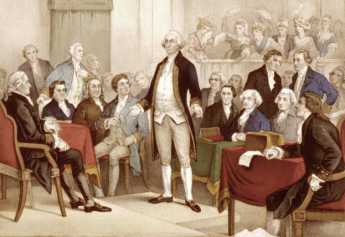
|
| Continental Congress |
THE British may well have been high-handed with their American colonies, but they were precise while enacting the Prohibitory Act of December 1775 about why they would attack militarily in 1776. Their American subjects had formed a rebel government in 1775 called the Continental Congress, which then dispatched an Army under George Washington to wage war against British forces in Boston; and then showed no signs of disbanding. What could you call that, except an armed mutiny?
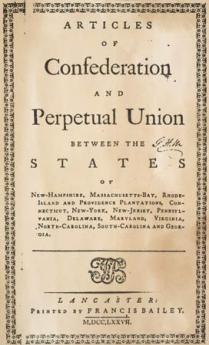
|
| Articles of Confederation |
The American colonists naturally had a different viewpoint. Because of the Prohibitory Act of 1775, they needed an established government of some sort to exist if war came, preferring not to be hanged for treason in defense of their rights as British subjects. Their primary grievance, at least at first, was taxation without representation. Many colonists were resistant to more than temporary independence from Britain. The most common goal of American moderates was then a variant of commonwealth similar to what was being discussed for Ireland. Once the British navy actually attacked, however, a strategic document describing what was contemplated for the far future was counter-productive. Strategic discussion bogged down into meaningless disputes between conservatives who wanted a strong central government, and radicals who argued for states' rights, neither of which was sufficiently tactical with British soldiers marauding the land.
To repeat the default position: Fighting the British fleet off Staten Island risked immediate hanging from the yardarm for treason, and the Articles of Confederation served the immediate purpose of legitimizing that. Lawyers may sometimes get lost in their own reasoning, but in this case, the advice was sound. Reconsidering the Articles after the Treaty of Paris was more appropriate, a smokescreen now only useful for confusing an angry British Admiral.
Although John Dickinson produced a workmanlike document in 1777 called the Articles of Confederation, it was weakened and not closely followed; formal ratification drifted during the first four years of the war. The chaotic situation also provided a pretext for some of the colonies to contribute less money or troops than their representatives promised. However, after five years of bloody warfare, an unratified Constitution became increasingly hard to justify, its disadvantages eventually outweighing any argument in favor. Robert Morris also decided the Articles needed to be ratified, as a sign of sufficient unity to justify long-term loans to them.
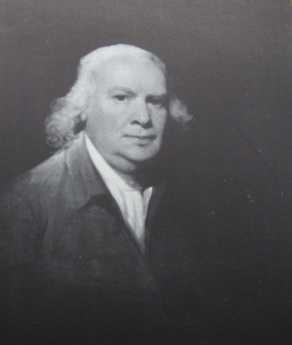
|
| Robert Morris |
Morris at that time was called the Financier, a poorly defined office which in his aggressive hands meant Morris was effectively running the country. His position put him in the center of unenforceable promises of aid from the thirteen states, justified to him in all the contradictory ways of beleaguered debtors. Morris was enough of a businessman to know that hard-pressed debtors frequently offer weak excuses. So, whether he felt he was thwarting phony evasions, or really believed the states had legal concerns, he pressed ahead vigorously for ratification of the Articles of Confederation. This was soon accomplished in 1781, but unfortunately, it made little difference. It can be safely surmised this experience hardened his long-expressed conviction that every federal government must at a minimum have realistic power to collect taxes to service its debts. But to accomplish that, now required those ratified Articles must be amended or replaced; he had made everything more difficult. It would now be six more years before the "perpetual" Articles could be unraveled, in the form of a new Constitution. That provided for federal taxation and going forward made it considerably easier to amend than by unanimous consent of all the states. There remained the awkwardness of that term "Perpetual". The whole experience was exasperating, but it surely left him and others determined not to be dissuaded by fine points of legal language.
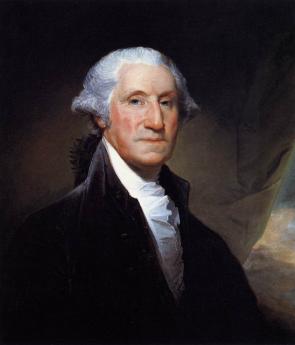
|
| George Washington |
Any perpetual agreement never to allow amendment (except by unanimous consent) is visibly unwise, but that was what confronted those who now proposed to amend the Articles. At the least, it pushed the decision in favor of replacing the whole document. It was easier to brush aside a perpetual legal document, as unreasonable than to argue that obtaining thirteen votes was impossible. George Washington had spent a lifetime constructing a reputation for always keeping his word. If even Washington could agree the situation was unreasonable, the public was of a mind to accept that absolutely anyone should agree. Anyway, the reasoning behind the language in the first place was that thirteen former colonies were joining together for a larger Union which would continue after the Revolution. It was the Union which was meant to be perpetual, not the Articles. Curiously, this change also made it easier to expand the union; imagine the difficulty of obtaining unanimous votes from fifty constituent states. There almost seems to be an ominous political axiom buried in this situation: as the number of voters grows, the majority margin must narrow if a deadlock is to be avoided.
The Revolutionary War, begun in 1775, continued from 1781 (Yorktown) to 1783. Even during four succeeding years of peaceful governance under the Articles, from the Treaty of Paris (1783) to the Constitutional Convention (1787), not a great deal happened. But a few things did come up to test the usefulness of the Articles. The small war between Connecticut and Pennsylvania was settled by the Decision of Trenton, although state boundaries became largely formalities after the country was unified by Article IV of the Constitution. The Northwest Ordinance was passed. And the Constitutional Convention was agreed to. Several flags were tested and adopted. Robert Morris had swept aside the habit of micro-managing the country by Congressional Committee, delegating government departments to bureaucracy in the process. Of all these activities, the most important was the Northwest Ordinance, which demonstrated that important governmental innovations could actually be accomplished under the Articles.
Democracies all like to talk too much. Their constitutions typically run to hundreds of micro-managed pages, and get everyone confused, unless they are unwritten, which is really confusing. It's hard to remember, but the Articles were the first written constitution, and to this day no other former member nation of the British Commonwealth has a written constitution. By giving things a trial run in the Articles of Confederation, we learned what is important and wrote it down. The second time around, tested in war and in peace, we made important revisions. By the time of the Civil War, we had a written governing document that men would die for because they understood it and approved.
39 Blogs
Christmas Reflections
 It once was a tradition to go back to the big city for Christmas shopping..
It once was a tradition to go back to the big city for Christmas shopping..
First Amendment: Separation of Church and State
 Eleven of the original thirteen colonies had,"established" religions. The separation of church and state by the First Amendment was not a statement of fact, but a worrisome departure from the past, mostly prompted by the behavior of the Virginia Episcopalians. For the Pennsylvania Quakers, disestablishment was a most disheartening event.
Eleven of the original thirteen colonies had,"established" religions. The separation of church and state by the First Amendment was not a statement of fact, but a worrisome departure from the past, mostly prompted by the behavior of the Virginia Episcopalians. For the Pennsylvania Quakers, disestablishment was a most disheartening event.
Puritan Boston & Quaker Philadelphia
 The University of Pennsylvania Sociology professor E. Digby Baltzell drew attention to the strong persistence of earlier elite influences, using Philadelphia's Quakers and Boston's Puritans as prime examples.
The University of Pennsylvania Sociology professor E. Digby Baltzell drew attention to the strong persistence of earlier elite influences, using Philadelphia's Quakers and Boston's Puritans as prime examples.
William Penn, Excellent Lawyer, Terrible Businessman
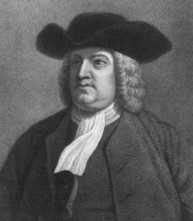 William Penn was the central force in the establishment of a religion, Quakerism, certain central features of the legal system, three colonies of America, and many of the central concepts of Constitutional Law. He leaves us over three thousand documents, but it remains very hard to form a picture of what he was like.
William Penn was the central force in the establishment of a religion, Quakerism, certain central features of the legal system, three colonies of America, and many of the central concepts of Constitutional Law. He leaves us over three thousand documents, but it remains very hard to form a picture of what he was like.
The Republican Court
 An aristocratic court may seem a peculiar place to unite a republic, but the female-dominated social circle of 1790-1800 nevertheless united a new nation. Its definition of who is socially prominent still persists, in SR -- the Social Register.
An aristocratic court may seem a peculiar place to unite a republic, but the female-dominated social circle of 1790-1800 nevertheless united a new nation. Its definition of who is socially prominent still persists, in SR -- the Social Register.
SEPTA's Long Term Planning
 SEPTA is slowly making progress, but it's a struggle, every step of the way.
SEPTA is slowly making progress, but it's a struggle, every step of the way.
Forming the State of Delaware
 In 1632, King Charles I granted to the Maryland proprietor coastal land with a northern border at the 40th parallel. In 1682, his son James the Duke of York evicted the Dutch from the Connecticut River to Cape Henlopen; afterward, his brother King Charles II gave away New Jersey and Pennsylvania, leaving York with New York plus a strip of wilderness from Pennsylvania to Henlopen. York then gifted that southern strip to William Penn before anyone realized there was a sloppy overlap with Maryland of thousands of square miles. Lawsuits are galore.
In 1632, King Charles I granted to the Maryland proprietor coastal land with a northern border at the 40th parallel. In 1682, his son James the Duke of York evicted the Dutch from the Connecticut River to Cape Henlopen; afterward, his brother King Charles II gave away New Jersey and Pennsylvania, leaving York with New York plus a strip of wilderness from Pennsylvania to Henlopen. York then gifted that southern strip to William Penn before anyone realized there was a sloppy overlap with Maryland of thousands of square miles. Lawsuits are galore.
Go to Delaware, Elephants?
 It's about a 20-minute commute from Delaware to Philadelphia, with a big difference in estate taxes. Moving from New Jersey to Delaware would double that difference.
It's about a 20-minute commute from Delaware to Philadelphia, with a big difference in estate taxes. Moving from New Jersey to Delaware would double that difference.
Urban Transportation
 The industrial revolution made cities grow, and thus made mass transit desirable. The flight to the suburbs then made mass transit attractive only to urban politicians.
The industrial revolution made cities grow, and thus made mass transit desirable. The flight to the suburbs then made mass transit attractive only to urban politicians.
Paying for College I
 A service economy needs more education past high school. Soaring college tuition costs imply a supply shortage, and hence we need more colleges.
But cheaper ones.
A service economy needs more education past high school. Soaring college tuition costs imply a supply shortage, and hence we need more colleges.
But cheaper ones.
Paying For College - II
 As college education strives to be universal, forcing a few prosperous students to subsidize many needy ones becomes unsustainable. Colleges must devise better tuition systems before somebody else does it for them.
As college education strives to be universal, forcing a few prosperous students to subsidize many needy ones becomes unsustainable. Colleges must devise better tuition systems before somebody else does it for them.
Heron Rookery on the Delaware
 Two or three miles from Philadelphia City Hall, a large flock of Blue Herons with seven-foot wingspreads are nesting in the trees, largely unnoticed.
Two or three miles from Philadelphia City Hall, a large flock of Blue Herons with seven-foot wingspreads are nesting in the trees, largely unnoticed.
What's Different About Kosher ?
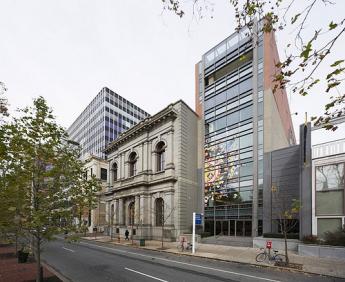 A recent conference at the Chemical Heritage Foundation examined the perplexing question of just what is signified by Kosher designation of food. Most of the curious audience were themselves Jewish.
A recent conference at the Chemical Heritage Foundation examined the perplexing question of just what is signified by Kosher designation of food. Most of the curious audience were themselves Jewish.
Cushman Club for Lonesome Actresses
 One of the ancient Camac Street clubs has closed its doors, to become a charitable foundation.
One of the ancient Camac Street clubs has closed its doors, to become a charitable foundation.
Pipe Organs, and Similar
 The pipe organ is an astonishingly ancient instrument, usually very expensive and hard to maintain, with many individual variations. The electronic organ is catching up and may surpass the pipe organ in a few decades, but that's guessing.
The pipe organ is an astonishingly ancient instrument, usually very expensive and hard to maintain, with many individual variations. The electronic organ is catching up and may surpass the pipe organ in a few decades, but that's guessing.
Pets For all Seasons
 Penn's Veterinary School has established a department for the study of pets and pet loving.
Penn's Veterinary School has established a department for the study of pets and pet loving.
Thieves of Baghdad
 American troops recovered most of the antiquities looted from the Baghdad Museum, tracing many of them through the international black market. The museum turns out to have been secretly a private treasury.
American troops recovered most of the antiquities looted from the Baghdad Museum, tracing many of them through the international black market. The museum turns out to have been secretly a private treasury.
Unalienable Rights Before 1776
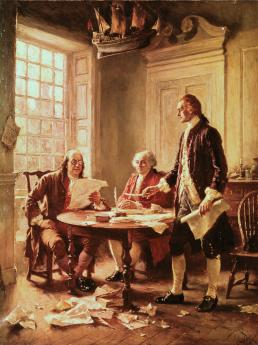 Lawyers commonly say the Declaration of Independence "informs" the Constitution. But prior informing was performed by William Penn, the Roman Empire, and Hammurabi.
Lawyers commonly say the Declaration of Independence "informs" the Constitution. But prior informing was performed by William Penn, the Roman Empire, and Hammurabi.
Inalienable Rights Before the Magna Carta
 Human rights of some sort can be traced back to 1800 B.C The question is not whether they are ancient, but who gave them out.
Human rights of some sort can be traced back to 1800 B.C The question is not whether they are ancient, but who gave them out.
Three Revolutions at Once, Maybe Four
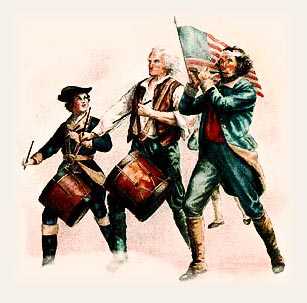 Asking the cause of the American Revolutionary War may be a little simplistic; civil wars pop up, all over the place, all the time. The more important question to ask, is why did this American Revolution have such a dramatic effect on the whole world?
Asking the cause of the American Revolutionary War may be a little simplistic; civil wars pop up, all over the place, all the time. The more important question to ask, is why did this American Revolution have such a dramatic effect on the whole world?
Special Education, Special Problems
 Until recently, mentally retarded children weren't even considered in school budgets. But in recent decades, they have become one of the biggest challenges.
Until recently, mentally retarded children weren't even considered in school budgets. But in recent decades, they have become one of the biggest challenges.
Willow Grove Park

Wood Turning
 Tucked underneath the Ben Franklin Bridge, a non-profit museum displays the work of turners, artists mostly working in their garages, a most endearing place to visit when you are near the Constitution Center in Philadelphia. A little hard to get there on one-way streets.
Tucked underneath the Ben Franklin Bridge, a non-profit museum displays the work of turners, artists mostly working in their garages, a most endearing place to visit when you are near the Constitution Center in Philadelphia. A little hard to get there on one-way streets.
Reservoir on Reservoir Drive

Selling Entire Towns
 Some builders build whole towns without houses and then sell them to custom home builders.
Some builders build whole towns without houses and then sell them to custom home builders.
New Roles For Grandparents
 The present generation of grandparents is inventing new rules.
The present generation of grandparents is inventing new rules.
Frank Furness (1):PAFA
 An art museum contains a lot of art. It should itself be a work of art if it can be.
An art museum contains a lot of art. It should itself be a work of art if it can be.
Frank Furness (2) Rittenhouse Square
 There were plenty of rich folks in Philadelphia before the Civil War. But it took the industrial revolution to make possible what we call the Victorian urban mansions.
There were plenty of rich folks in Philadelphia before the Civil War. But it took the industrial revolution to make possible what we call the Victorian urban mansions.
Exercise As Fun
 You can't improve muscle strength unless you have some muscles, and you can't improve endurance until you have some strength.
You can't improve muscle strength unless you have some muscles, and you can't improve endurance until you have some strength.
Stop Slapping Your Feet!
 Just sit on a park bench and listen to people walking by. If they slap their feet, they don't know how to walk, no matter how old they are.
Just sit on a park bench and listen to people walking by. If they slap their feet, they don't know how to walk, no matter how old they are.
There She Goes, Miss America
 The Miss America contest is all changed and different, but maybe it stays the same.
The Miss America contest is all changed and different, but maybe it stays the same.
Disappearing Stock Power
 The proxy voting power of corporate common stock is disappearing every day, by thousands of shares.
The proxy voting power of corporate common stock is disappearing every day, by thousands of shares.
Killer Instinct
A former Marine and carrier pilot reflects  on the non-boastful risk-takers who drive themselves toward success, but not for riches, promotions, or power. Many other nations seem to exclude these people, and while many women go wild over them, feminists want to civilize them, at our peril.
on the non-boastful risk-takers who drive themselves toward success, but not for riches, promotions, or power. Many other nations seem to exclude these people, and while many women go wild over them, feminists want to civilize them, at our peril.
Insomnia
 Between 6 and 10% of the population describes itself as suffering from chronic insomnia.
Between 6 and 10% of the population describes itself as suffering from chronic insomnia.
America's New Theater Capital
 New York's professional theaters have mostly become a tourist industry. The new capital of legitimate theater in America is -- Philadelphia.
New York's professional theaters have mostly become a tourist industry. The new capital of legitimate theater in America is -- Philadelphia.
Ms. Mayor
 The current, and long time, Mayor of Haddonfield New Jersey is a lady from Odessa, Texas.
The current, and long time, Mayor of Haddonfield New Jersey is a lady from Odessa, Texas.
Rationing, No Matter What You Call It.
 The ethics of healthcare reform concentrate on the ethics of healthcare rationing.
The ethics of healthcare reform concentrate on the ethics of healthcare rationing.
Obituaries, 2010
The Right Angle Club lost two of its former presidents, during the past year. They are missed with admiration and affection.
American Articles of Confederation, Valuable or Hindrance?
 The American Articles of Confederation were devised and then completed in Philadelphia. Correcting their biggest flaws made it easier to accept a sparse Constitution which is hard to amend. But it gave the British a legal way to hang them as rebels.
The American Articles of Confederation were devised and then completed in Philadelphia. Correcting their biggest flaws made it easier to accept a sparse Constitution which is hard to amend. But it gave the British a legal way to hang them as rebels.